|

Rudolf Siebert (1927) and Leo Semashko (1941), scorched by war
Photo 2006, St. Petersburg, Synergy Start in Peace Science -----------------------------------
GGHA is 20: 2005-2025: https://peacefromharmony.org/?cat=en_c&key=1251

-------------------------
PEACE SCIENCE for the War-sick Humanity is
its healing, survival and prosperity!
In English: https://peacefromharmony.org/?cat=en_c&key=1187 In Russian: https://peacefromharmony.org/?cat=ru_c&key=1070 Dr. Leo Semashko, GGHA Founder and Honorary President 27-04-24 -----------------------------------
World recognition of the "Spherons Global Peace MegaScience" (SGPM),
Spheronics.
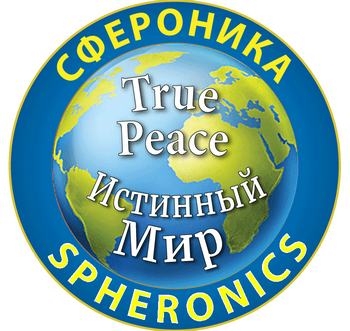
https://peacefromharmony.org/?cat=en_c&key=1129
-----------------------------------
WGF Magazine. June 2023, 50-56 p. Dr. Leo Semashko. HUMANITY IS ABLE TO LIVE IN GLOBAL PEACE, WITHOUT WARS AND VIOLENCE: https://worldgrowthforums.com/world-growth-forums-magazines/wgf-mag-jun-2023/ 50-56 p.
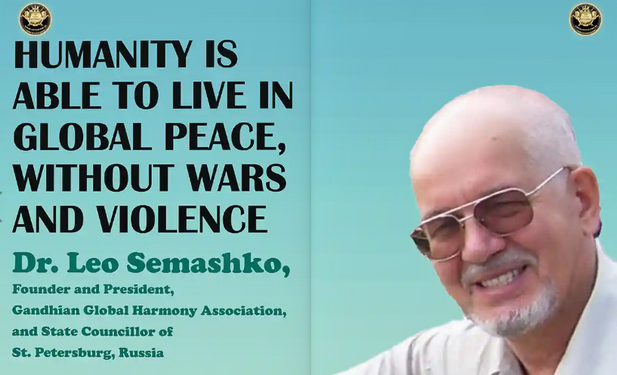
---------------------------------
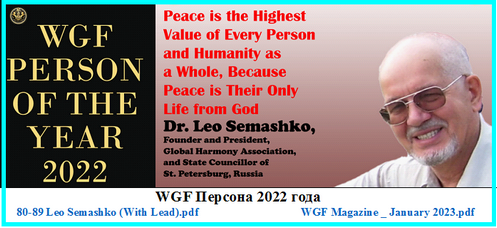
https://peacefromharmony.org/?cat=en_c&key=1153
Peace Petition: https://chng.it/XChFWM7c86
-----------------------------------
https://worldgrowthforums.com/world-growth-forums-magazines/wgf-mag-jan-2022/ 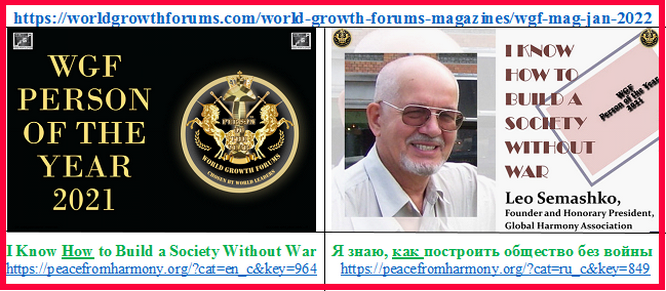
"Person of the Year 2021." According to the International Journal: World Growth Forums (WGF). For published article of Leo Semashko: "I Know How to Build a Society Without War" https://peacefromharmony.org/?cat=en_c&key=964 PDF: https://peacefromharmony.org/docs/Leo-Semashko-WGF-Person-of-the-Year-2021-Prize-Post.pdf
----------------------------------------------------------------------
Nomination of the GGHA and its leader for the Nobel Peace Prize
2013: www.peacefromharmony.org/?cat=en_c&key=586 2017:
http://peacefromharmony.org/?cat=en_c&key=788
2020:
https://peacefromharmony.org/?cat=en_c&key=934 -------------------------------------------------- India President, Dr. Abdul Kalam, the first world leader who recognized the SGPM as the first harmonious worldview, vision of peace and prosperity for all the Earth nations, for building harmonious civilization in his appreciation of the GHA book "The ABC of Harmony for Global Peace, Harmonious Civilization and Tetranet Thinking" , New Delhi. 2012, which he co-authored, as the SGPM early version: https://peacefromharmony.org/?cat=en_c&key=489
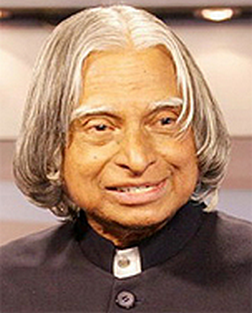
Dr. APJ Abdul Kalam, President of India, 2002–2007, poet: https://peacefromharmony.org/?cat=en_c&key=95
“The world needs the great vision of peace and prosperity. The ABC of Harmony is the dawn of a shining, harmonious vision of peace and prosperity for all the nations of the planet Earth! Together with it, the enlightened citizens will emerge, capable of building a harmonious civilization of peace and prosperity on the planet Earth!” The GHA Highest Honorary Title: WORLD HARMONY CREATOR: https://peacefromharmony.org/?cat=en_c&key=513 ------------------------------------------------------- The GGHA Spheronics MegaScience coauthors of the volunteer “Spherons Global Peace Academy” (SGPA). It consolidated 750 coauthors of spheronics during 18 years, since 2005, from more than 50 countries with the participation of India President Abdul Kalama and 5 Nobel Peace Laureates.
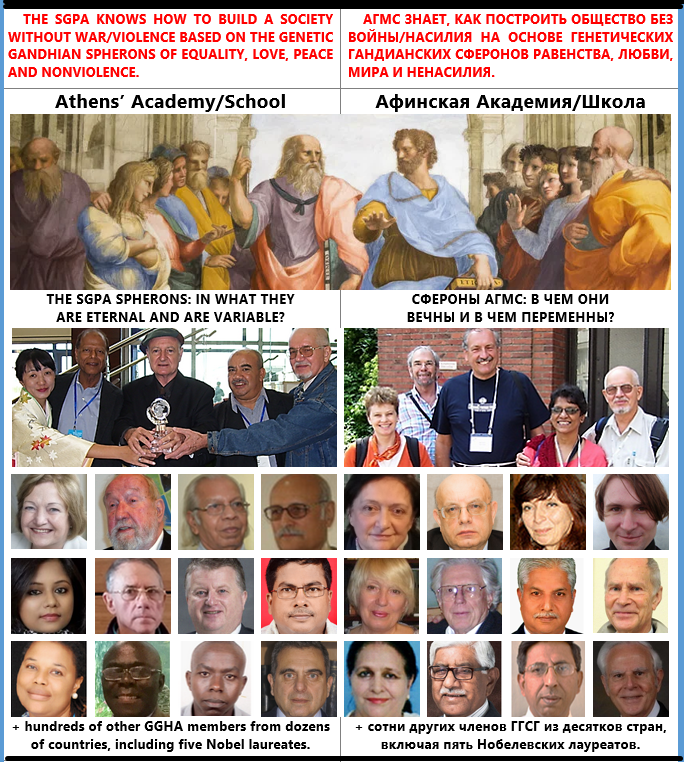
https://peacefromharmony.org/?cat=en_c&key=1000 ---------------------------------------
Global Community letter to Dr. Leo Semashko by Germain Dufour, June 2016:
https://globalcommunitywebnet.com/Dialogue2016/Newsletter/July2016/Semashko.htm
-------------------------------------------------
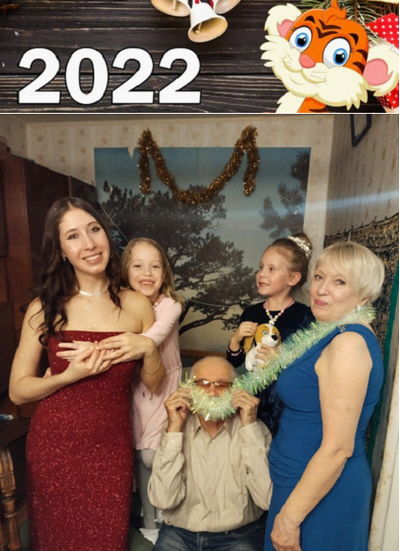
31-12-21
-------------------------------------
Great and singular message from Leo Semashko (https://peacefromharmony.org/?cat=en_c&key=619),
which I strongly recommend to read complete and including the link https://en.wikipedia.org/wiki/Heart_of_a_Dog.
Leo is a great intellectual of the present century. Ernesto Kahan, Professor, Physician, IPPNW Vice-President in 1985 - Nobel Peace Laureate, Israel, https://peacefromharmony.org/?cat=en_c&key=338 05-06-21
--------------------------------------
Leo Semashko I Know How To Build A Society Without War. Interview for the International “World Growth Forums” Magazine, October 2020. Published: https://www.worldgrowthforums.com/ https://peacefromharmony.org/?cat=en_c&key=964
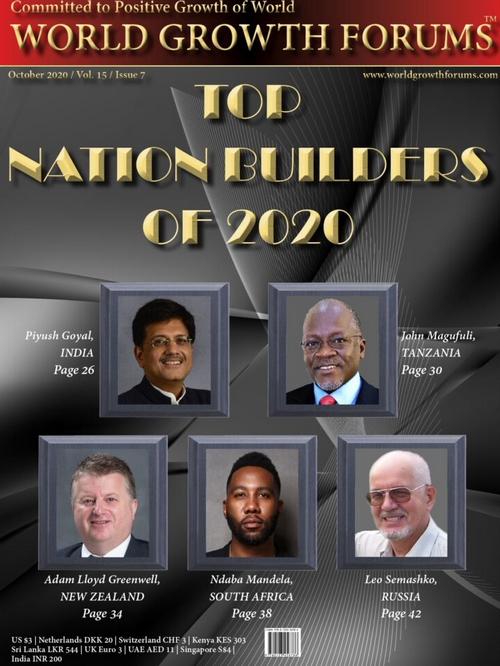
The WGF special page:
https://worldgrowthforums.com/world-growth-forums-magazines/monthly-issues/october-2020/leo-semashko/
----------------------------------------------------------
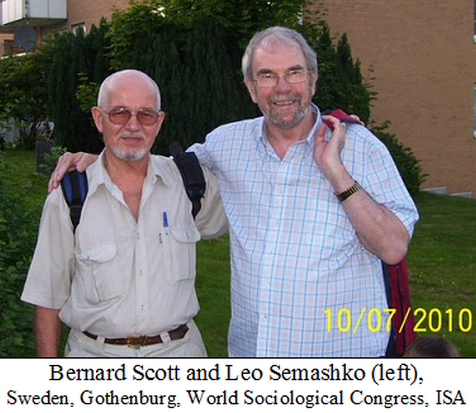
https://peacefromharmony.org/?cat=en_c&key=253 https://peacefromharmony.org/?cat=ru_c&key=286

Honorary Presidents: Walter Buckley†, USA; Felix Geyer, The Netherlands
https://www.isa-sociology.org/en/research-networks/research-committees/rc51-sociocybernetics/ FROM: Dr. Bernard Scott BTech MSc PhD PGCE AFBPS FCybS ASCF Academician of the IASCYS Past President RC51 (2006-2010) Independent Academic Lincolnshire UK TO: The GHA Board I confirm that Dr. Leo Semashko, ISA RC51 Sociocybernetics member since 2000, was made an Honourary Lifetime Member of RC51 by the RC51 Board at the ISA Congress, Toronto (July, 2018). Signature: Bernard Scott bernces1@gmail.com
https://peacefromharmony.org/?cat=en_c&key=255
Date: May 20th 2020.
----------------------------------------------------------
Mairead Maguire Nobel Peace Prize 2020 nomination of Dr. Leo Semashko:
https://peacefromharmony.org/?cat=en_c&key=934
--------------------------------------------------------------------------
“The Gandhian Spherons Nonviolent Victory over nuclear weapons, war and militarism
is inevitable in the XXI century!” Today, May 9, 2020, I can proudly repeat that I intellectually killed the war that killed my father on June 22, 1941. I killed it with the Gandhian law of varnas/spherons, which Gandhi began to write about almost a century ago, but which remained inaccessible science and society because of its lack of development and modern scientific rationale. I, for over 40 years and the GHA for 15 years developed this law in detail and substantiated it with world statistics from 76 countries. It is presented in 9 books and 77 GHA peacemaking projects, especially in “Global Peace Science” (2016) and most of all in “Gandhica” (2019). The final result of our great work was the Divine insight, which appeared to me on May 9, 2020 in fundamental historical prediction above! Mahatma Gandhi knew and predicted this victory almost a century ago. We, the GHA, now KNOW HOW it will happen and WHEN! It consciousness in our books and projects is ahead of its reality and accomplishment. This is the law of spirituality and science! Today we know how and when the Gandhian Spherons Nonviolent Victory over nuclear weapons, war and militarism will occur. We know that in our century only the Spherons are able to realize this Victory - NOBODY is capable of it anymore. This is the law of the societal peaceful nature of the Spherons, discovered by Gandhi. Read more about it in the GHA Victory Message: https://peacefromharmony.org/?cat=en_c&key=942. The nonviolent Gandhian Victory of the Spherons will fulfill the dream of all the deceased for the first, in 1945: THAN THERE WASN'T WAR! This is a deep, invisible connection between the times and victories of human history, which we saw after Gandhi and raised to the level of necessary science of our century. I fulfilled the testament of my beloved mother, Augusta Rumyantseva (b. 1920), who saved me, a newborn (June 20, 1941) in fascist bloody bombing during a week's evacuation from Grodno, where I was born. Eternal glory and memory to the war heroes, who saved our lives so that we end the war! Leo Semashko, May 9, 2020
---------------------------------------------------------------------------
My brief autobiography to understand the source of my firm anti-militaristic peacemaking position,
“private interest” and motivation, which began with my birth in the war and the death of my father. Dr. Leo Semashko, Born on June 20, 1941 b., 2 days before the Eastern Front of World War II, In the early days of which my father, the Red Army lieutenant, was killed. I am philosopher, sociologist, thinker and peacemaker from social harmony Excluding war. My Credo and uncompromising meaning of life: I am the Global Harmony Association (GHA) Founder (2005) and Honorary President (2016)
with the mission “Peace from Spherons' Harmony”,
uniting more than 600 members from 65 countries. I am the initiator, co-author and editor-in-chief of the GHA unique peacemaking achievements for almost 15 years of its work:
70 peace projects, including Kashmir, and 9 fundamental books, including: Harmonious Civilization (2009), The ABC of Harmony (2012), Global Peace Science (2015/6), Gandhica (2019),
Antinuclear Manifesto XXI (2020)
+ GGHA Message: Women's Peace Revolution (2024: https://peacefromharmony.org/?cat=ru_c&key=388)
List of the GGHA peace-projects: https://peacefromharmony.org/?cat=en_c&key=472
-----------------------------------------------------------------------------------------
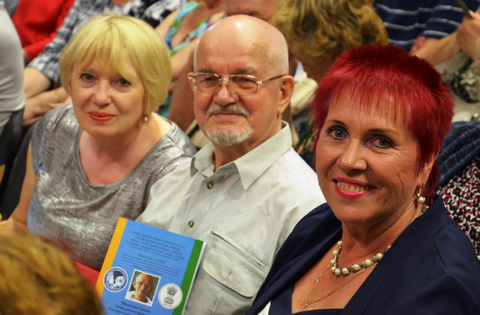
With a new book “Gandhica” and coauthors, 07/27/19 https://peacefromharmony.org/?cat=ru_c&key=788
------------------------------------------
Þðèé Öûìáàëèñò Ïîýò, Ìîñêâà, Ðîññèÿ ÍÅÒ ÂÎÉÍÅ! Ïîñâÿùàåòñÿ Ë.Ì.Ñ. Îñíîâû Íàóêè Ãëîáàëüíîãî Ìèðà Âàÿåò ñåäîé, ïîæèëîé ÷åëîâåê. Êîìïüþòåð, æåíà è «îäíóøêà» -êâàðòèðà  êîëüöå ïåòåðáóðãñêèõ äèêîâèí è ðåê… Ñîþç ïëàíåòàðíûé ðåñïóáëèê ñâîáîäíûõ, Áåç âîéí, ìÿòåæåé, ãåíîöèäà è çëà – Âîò öåëü âñåõ óñèëèé åãî áëàãîðîäíûõ. Îí åé ïîñâÿòèë è ñëîâà, è äåëà.
Òåòðàðíûé ïîäõîä èì ïðåäëîæåí äëÿ Ìèðà. ×òî æ, êòî-òî ïðèåìëåò, à êòî-òî íå ðàä. Âîò òàê æå ïîýòîâ êàïðèçíàÿ Ëèðà Âåêàìè âåëà ê áëåñêó ïîçäíèõ íàãðàä… Êàçàëîñü, âñ¸ ÿñíî: ãàðìîíèÿ, ñ÷àñòüå, Ëþáîâü è äîñòàòîê – òâîðè äà æèâè!.. Íî ïðàâÿò Çåìë¸é âàøèíãòîíñêèå âëàñòè, ×åé áèçíåñ çàìåøàí íà íàøåé êðîâè. Áåçäóøíûé ðàçãðîì äðåâíèõ öèâèëèçàöèé – Âîò ïî÷åðê íàöèñòîâ è ñëóã ñàòàíû. ÎÎÍ çàãèáàåòñÿ, êàê Ëèãà Íàöèé,  ïðåä÷óâñòâèè íîâîé è ñòðàøíîé âîéíû… Ýëèòíûé êâàðòåò äàâèò ìèð íà ïëàíåòå: Îáàìà è Êýìåðîí, Ìåðêåëü, Îëëàíä. È ãèáíóò ïîâñþäó áåçâèííûå äåòè Îò ïóëü «äåìîêðàòàìè» âñêîðìëåííûõ áàíä. Òàê ñêîëüêî åù¸ ïðåìèé «ìèðà» ïðèñóäÿò Óáèéöàì êóëüòóðû, íàäåæäû, ëþáâè? Íåóæòî íàáàò íèêîãî íå ðàçáóäèò? Ñïàñè, Áîæå ïðàâûé, è áëàãîñëîâè Íàðîäû Çåìëè íà ñâÿòîå ñðàæåíüå Çà ïðàâî ëþäåé îñòàâàòüñÿ ëþäüìè. Íàñòàâü âëàñòîëþáöåâ – íà÷àòü èçó÷åíüå Îñíîâ ìèðîëþáèÿ – è âðàçóìè… È âíîâü – Ïåòåðáóðã è «îäíóøêà» -êâàðòèðà, Êîìïüþòåð, æåíà… Äëÿ ëþäåé, äåíü çà äí¸ì, Ñåäîé ÷åëîâåê ÷åðòèò ëèíèþ Ìèðà È äàðèò îñíîâû Íàóêè î í¸ì… Ëåòî 2014 Web: https://peacefromharmony.org/?cat=ru_c&key=480 ----------------------------------------
-----------------------------------------
“The war killed my father, and I killed war”
About Leo Semashko’s life path in his main achievements
within Sociocybernetics of harmony
By Robert M. Weir, American writer and peacemaker Author, speaker, advocate for “peace through understanding” http://robertmweir.com/roberts-bio/ Published: In English: http://peacefromharmony.org/?cat=en_c&key=239 http://peacefromharmony.org/?cat=en_c&key=253 In Russian: http://peacefromharmony.org/?cat=ru_c&key=286 http://peacefromharmony.org/?cat=ru_c&key=273 In French: http://peacefromharmony.org/?cat=fr_c&key=145 In Spanish: http://peacefromharmony.org/?cat=es_c&key=116 In Greek: http://peacefromharmony.org/?cat=gr_c&key=14 In Portuguese: http://peacefromharmony.org/?cat=po_c&key=94 In Arabic: http://peacefromharmony.org/?cat=ar_c&key=15 The war killed my father, and I killed war.
I deprived its vital source in the false faith of its eternity
by my spheral science of genetic peace from world harmony. This integral science creates nonviolent holistic thinking,
fulfills Einstein’sfundamental paradigm of “peace through understanding,” and
opens a conscious, peace-loving path for harmonious civilization of the future,
excluding all wars. Leo Semashko
I erected a monument to myself not made by hands ...
Alexander Pushkin Leo Mikhailovich Semashko (born June 20, 1941) is a Russian visionary, philosopher, sociologist, author and peacemaker. He is founder and president of the international peacemaking organization Global Harmony Association (GHA) and an honorary member of RC51, Sociocybernetics, International Sociological Association. His more than 600 scientific publications, including 18 books, focus on his discovery and development of scientific theories of tetraphilosophy, global sociology and harmonious civilization. He is the discoverer of spherons, Tetrasociology or third order Sociocybernetics, Tetrapsychology,spheral statistics and global peace science. Contents 1.Youth, education and career 2.Global Harmony Association 3.Discoveries and achievements 3.1 Tetraphilosophy 3.2 Tetrasociology 3.3 Spheral resources 3.4 Spherons 3.5 Tetrapsychology 3.6 Spheral science 3.7 Spheral statistics 3.8 Spheral Information Statistical Technology (SIST) 3.9 Spheral Democracy 3.10 Global Peace Science (GPS) 3.11 Tetranet Thinking Paradigm (TTP) 4.Global Harmony Association projects 1.1 Women’s Project 1.2 Social Priority of Children 1.3 Harmonious education and the Age of Harmonious Enlightenment 1.4 Peaceful cooperation between the United States and Russia 1.5 Restructuring the United Nations 1.6 Human/Humanity Right to Life, Global Peace and Social Harmony 1.7 Harmonious Civilization: Spheral futurology 5. Published works 6. Peace from Harmony web site Youth, education and career Dr. Leo Semashko was born June 20, 1941, in Grodno, Belarus, a city close to the borders with Poland and Lithuania. Leo’s 22-year-old father was killed in Grodno during the first days of World War II, a fact that shaped the young boy’s destiny and spun his life and work into spiritual and sociological arenas, with the goal of helping nations attain world peace. Dr. Semashko is a graduate of the Faculty of Philosophy (1965) and alumnus of post-graduate studies (1970) from Moscow State University, Department of History of Foreign Philosophy, with a thesis on ancient philosophy. His scientific adviser was Professor Igor S. Narsky; his scientific mentor was Professor Valentin F. Asmus. He has lived and worked in St. Petersburg, Russia, since 1971. With a PhD in philosophy, Dr. Semashko is Professor RANH (Russian Academy of Natural History). He has been a teacher of philosophy, sociology and political science in a number of universities until 2004; a member of the Leningrad/Petersburg City Parliament of the 21st convocation from the city’s 48th constituency since 1990 to 1993; and has been an Actual State Counselor of St. Petersburg, class III, since 1998. He was also founder and leader of the Spheral Democracy Deputy’s Faction in the Petersburg Parliament (1992-1993); founder and president of the Children’s Foundation, named by Feodor Dostoevsky, in St. Petersburg (1990-1997); founder and chair of a group of developers for the first project of the Family Code in Russia, with the first chapter dedicated to advancement of children’s rights (1990-1991); creator of the Global Harmony Association (2005); and a participant in other socially oriented endeavors not named here. Since 1990, he has participated in many international peacemaking and sociological congresses in Australia, Asia, Africa and Europe. Global Harmony Association As a philosopher, sociologist and peacemaker, Dr. Semashko has emphasized social and human harmony. In 2005, he founded the Global Harmony Association (GHA), an informal international peacemaking organization that now consists of more than 600 humanitarian scholars and peacemakers from 65 countries as well as many collective members.In 2016, he was elected as GHA’a honorary president. Since its creation more than 13 years ago, Dr. Semashko and other GHA members have collectively initiated 60 peacemaking projects and created eight books, with more than 400 co-authors from 45 nations, that have been published in several languages. The GHA and its leader were twice nominated for the Nobel Peace Prize (2013 and 2017).Since 2007, 15 outstanding world leaders, peacemakers and scholars of humanities associated with GHA have been honored as “World HarmonyCreator” for their unprecedented contribution to global peace from harmony.(http://peacefromharmony.org/?cat=en_c&key=513) Discoveries and achievements In 1976, Dr. Semashko authored the fundamental discovery of “spherons” (spheral classes of the population employed in four spheres of social production), which is supported empirically by a number of statistical studies. The concept of spherons is the foundation for Dr. Semashko’s new scientific, holistic disciplines: tetraphilosophy, tetrasociology, spheral statistics and global peace science, as well as new, emerging, interrelated global digital technologies. The theory of spherons is the integrating center, the structural core and heart of a single spheral humanitarian science as a whole. This theory unites and reconstructs traditional social sciences, overcoming their eternal fragmentation and providing them with ontological unity and epistemological holism. Tetraphilosophy Tetraphilosophy is a four-dimensional pluralistic and holistic philosophy that originated from the ontological cosmogonic concepts of the Greek philosopher Empedocles. It continues, synthesizes and develops the four-dimensional spheral ideas of Immanuel Kant and cosmism, especially Russian cosmism in ontology, and similar pluralistic ideas of social philosophies by Augusto Comte, young Karl Marx, Maxim Kovalevsky, Max Weber, Robert Park, Karl Jaspers, Pitirim Sorokin, Talcott Parsons, Fernand Braudel, Alvin Toffler, Jürgen Habermas, Pierre Bourdieu, Anthony Giddens, Edward Soroko, Bernard Scott, Rudolf Siebert and many others. Tetraphilosophy recognizes four equally necessary, sufficient, and inseparable and harmoniously interconnected (mutually including) ontological grounds/elements/beginnings: individual existence, information, organization/order and matter. These elements constitute specific spheres of integral being at all levels: cosmos, society, man (mankind) and “I” (the individual). The interrelation, continuity and mutual multi-dimensional inclusion of spheres of different levels are determined by a single ontological regularity of their spheral structural harmony. According to Henri Poincare, this “inner harmony of the world is the only true objective reality.” Tetraphilosophy excludes the primacy/primordiality of any specific cosmogenic origin, but it recognizes the variable priority of any of the four elements at different historical spaces and times. Synonyms of tetraphilosophy, which emphasize its different aspects, are tetrism, four-dimensional pluralism and harmonism. Tetrasociology Tetrasociology is the social part of tetraphilosophy, the subject of which is social harmony, global peace and harmonious civilization throughout humanity’s entire history. Tetrasociology manifests society as the continuous evolution of the four spheres of social production, which, in the terminology of Chilean biologist Humberto Maturana, constitutes the social form of the biological “autopoiesis” (self-production). The four spheres of social production or social autopoiesis are a form of existence and development of any society in its evolution and history. Spheres produce four societal spheral resources, constituting both the subject and product of these spheres, according to which they are differentiated and structured. Spheral resources Spheral resources are the four equally necessary macro resources that must work and mesh together in order for humanity to continue social and individual living: People, Information, Organizations and Things, which are material goods and services (PIOT). The absence of any one of these spheral resources makes human life and continuation of society impossible. Relatedly, an equal societal value of PIOT resources, regardless of their number, determines the equal societal value of the corresponding spheres and spherons of social production. Together, this harmonious balance among theequal PIOT resources, spheres and spherons expresses society’s genetic noospheral pluralism, its autopoietic unity as well as its plurastic harmonious nature as a whole. Spherons Spherons are the four equally necessary societal spheral classes/communities of the population that are employed in four spheres of social production: sociospheron, which is employed in the sociosphere; infospheron, which is employed in the infosphere; orgspheron, which is employed in the orgsphere; and technospheron, which is employed in the technosphere. Spherons differ neither in property, nor in power, nor in other partial qualities but only in the fundamental, vital employment of people in one of the four spheres of social production that produce the four necessary and sufficient spheral resources of PIOT. During a person’s non-working ages, from birth to adulthood as well as in old age, each individual receives the benefits of social production through the relevant institutions of a caring family, education, health services, social welfare and so on; in this capacity, the individual forms the passive part of the sociospheron. In contrast, during working age, the individual actively contributes to society’s spheral structure by being employed in one sphere or another, one of which the individual makes a priority concerning his/her work time. Spherons’ stochastic balance constitutes the societal harmonious structure of every society. Thus, spherons are the fundamental units and actors of this structure, the spontaneous interconnection and mutual limitation of which ensures the structural harmony of all social production. Tetrapsychology Tetrapsychology is a psychological, individualistic part of tetraphilosophy. Tetrapsychology studies and reveals the spheral structural harmony at the level of the individual in its four spheres: character, consciousness, will and body, which constitute the spheral psychological genome, “psynome.” Tetrapsychology, along with the spherons, was discovered by Dr. Semashko, but it was scientifically expressed and defined only in 2012 in Dr. Semashko’s and GHA's book The ABC of Harmony. Tetrasociology and tetrapsychology, as well as society and individual, are united by the spheral similarity of their structural harmony. Spheral science Spheral science is a single, holistic, socio-humanitarian science based on the knowledge of the spheres and spherons of social production in their structural harmony. This knowledge inherently integrates all diversity of traditional humanitarian branches and disciplines into the holistic scientific vision of spheral social production in the form of a harmoniously ordered diversity of system aspects and directions within this vision. Spheral science, then, in the broadest sense, is Tetrasociology or Sociocybernetics of spheres and spherons, which constitutes the third order Sociocybernetics. The subject of spheral science is the social four-dimensional autopoiesis in the structural harmony of spheral resources, productive spheres and spherons in the continuous stochastic process of their spheral employment.Unfortunately, traditional social science and humanitarian knowledge today are still in an extremely depressed, fragmented and embryonic state, a primitive condition that rejects and impedes fundamental spheral discoveries. Even the most peaceful, dynamic and progressive world leaders, such as Russian President Vladimir Putin, are not yet able to understand the acute need, the role and significance of the fundamental Copernican renewal of the social and human sciences(http://peacefromharmony.org/?cat=ru_c&key=666). Spheral statistics Spheral statistics is one of the fundamental parts of the spheral science (tetrasociology, third-order sociocybernetics) that provides this science with quantitative harmonious measurements of spheres, spheral resources and processes, spherons and other spheral attributes of holistic social production at all its levels, from the individual and the family to the country and to all global humanity. Based on spheral statistics and its indices, an adequate mathematical description and “digitalization” can be created to measure the harmoniousness of integral social production, the balances and proportions of societal spheres and spherons, and the stability and effectiveness of any given society. Spheral statistics, then, provide an empirical basis for spheral science, which begins with the statistical knowledge of spherons and their interactive dynamics over time at different levels. The discovery of spheral statistics creates a single, logically ordered, universal and global social space of spheral statistical indices for all countries, industries/branches, corporations, governments and spheres of social production. Spheral statistics aggregatesand integrates indicators of traditional statistics to overcome the fragmentation and limitations of those traditional statistics. Spheral statistics give the indices of spherons as a social genome (socionome) that defines the measurement of the structural harmony of social production of any country in any historical period. Spheral statistics have become a platform for a number of unique digital technologies, such as Spheral Information-Statistical Technology (SIST) as a first step to help foster world peace through the conscious and controlled harmony of a spheral global “digital” economy, excluding crises and unexpected risks of disharmony. Spheral Information-Statistical Technology (SIST) The greatest development, justification and application of spheral statistics is Spheral Information-Statistical Technology (SIST), which Dr. Semashko perfected and used in the development of many urban projects when employed at the St. Petersburg City Planning Commission’s statistical institute, System Engineering, since 1980 through 1988. Like atomic energy and some other modern technological discoveries, spheral statistics and SIST have a double/duplex use: they can be constructive, providing global peace and common societal good for the fraternal unity of countries and people in a harmonious multipolar world order. Or, they can be destructive/military, capable of creating economic instability, disharmony and societal collapse nonviolently like the "Great Depression" or the USSR disintegration. The destructive option of spheral statistics and SIST may be applied, for example, by world peace organizations, such as a restructured United Nations, to any state-aggressor to nonviolently ensure global security, peace and stability from harmony. According to Dr. Semashko’s opinion, spheral statistics and its technologies have an unlimited range of effective applications in all spheres of world digital economy. These tools allow to regularize and streamliningthe Internet global information space,to turn its chaos into some kind of harmony and to ensure a gradual approximation to it, as well as repeatedly to increase the precision and efficiency of the search in it. on their basis, fundamentally new models of global environmental security governance are built for the UN and other international organizations. In addition, on their basis, self-government models of personal growth can design for each individual. Their use can ensure the peoples of all countries with millions of new innovative intellectual jobs and unlimited investments in the 21st century. Spheral Democracy Spherons and spheral science are able to provide an evolutionary, nonviolent transformation of traditional democracy as plutocracy—with its congenital defects of militarism, inequality, corruption and nationalism—to a full, 100 percent spheral democracy that encompasses and serves the interests of the entire population, including women and children. Spheral democracy is based on scientific knowledge of each spheron’s objective equality within a harmoniously structured society. The spherons objective equality demands to recognize the equally necessary role of each spheron that it plays in social production. This knowledge requires and allows a highly functional society to divide all forms of political power at all levels of government, fixating for each of the four spherons an equal (25 percent) quota of representation in the legislative, judicial and executive governmental decision-making bodies. A similar division of power between fundamental spherons (between spheral classes/communities of the population) is necessary today. In order to be truly harmonious, society must create a decision-making structure in which there is an equal quota representation in all democratic institutions, regardless of the number of people and property value (wealth) of any particular individuals within any of the spherons. This equanimity creates a condition in which society is at the service of all its people and not at the service of the small percentage of the population (the wealthy elite); thus, it ensures a full and balanced, harmonious nature of spheral democracy that can overcome all the innate defects of traditional democracy that is evident in many countries today. Global Peace Science All categories and discoveries of the spheral science are organically integrated by Dr. Semashko in the special Global Peace Science (GPS), which is still not universally developed and, thus, is absent in most countries. GPS is an alternative to “military science,” which has flourished for more than two centuries in all countries, resulting in an endless number of military academies and colleges as well as prioritization of extremely expansive military endeavors, armament build-ups and colossal military budgets. Global Peace Science reveals the objective laws and fundamental actors of global peace from the societal structural harmony of the spherons. Thus GPS can be used by nations and governments to overcome all disharmonies and imbalances of social production that generate violence, wars and armed conflicts. GPS allows societies to build a long-term global strategy for achieving universal peace and disarmament within the next 50 years, based on the mechanisms of spheral democracy at all levels of government, including the United Nations. Tetranet Thinking Paradigm (TTP) Based on spheral categories and spheral indices, Dr. Semashko created a fundamentally new paradigm of spheral, global, harmonious, holistic and networked thinking that he called the Tetranet Thinking Paradigm (TTP). Tetranet thinking is four-dimensional thinking by spheres and spherons at all levels of social autopoietic cosmos within the framework of the philosophical thinking of the four ontological spheres of being. Thus, TTP integrates all the achievements of traditional, branch or partial thinking in order to overcome the fragmentation and limitation of that 20th century mindset. TTP also allows people and governments of the world to find nonviolent, harmonious solutions to all historical and current global challenges andrisks. TTP offers a constructive intellectual tool for the embodiment of the 20th century’s brilliant covenants and the solution of global challenges expressed by their visionaries, among them: Henri Poincare, who said, “The inner harmony of the world is the only true objective reality.” Albert Einstein, who said, “We shall require a substantially new manner of thinking if humankind is to survive.” Martin Luther King, Jr., who said, “We should shift the arms race to a peace race.” To which John F. Kennedy, speaking to the United Nations General Assembly, added, “Mankind must put an end to war before war puts an end to mankind.” Therefore, using the expression of the Russian geochemist Vladimir Vernadsky, one can say that TTP is scientific thinking that constitutes “the greatest shift of human thought, which takes place only once in the millennia.” TTP also builds on the wisdom and soft harmonious force of women. It was the Russian theosophist, writer, and public figure Elena Roerich who said, “In the hands of a woman, now is the salvation of humankind and the planet. The Age of Woman has come, and the woman must raise the thinking of humanity to the next step.” TTP brings forth the necessity of true gender equality that is humorously expressed in the American aphorism: “If Mama isn’t happy, nobody’s happy.” Global Harmony Association projects Women’s Project Dr. Semashko and the Global Harmony Association applied spheral analysis with an evaluation of feminist achievements of the last 100 years to create a foundation for continuation of the new feminist movement in the 21st century. This endeavor began with a reconstruction of the feminist heritage of Helena Roerich, who, in the early 1900s, rode side by side with her husband, Nicholas Roerich, as they, together, explored the great remote expanses of southern Russia, China and Himalayan India. From that, came a deeper definition of Elena Roerich’s philosophy of “harmonious feminism” or “fourth wave feminism.” GHA developed Helena Roerich’s theoretical conclusions and integrated them with spheral intellectual tools to form the conceptual basis of the GHA project called New Women. This project connects the idea of true equality of women, primarily in the economic and political spheres, with women’s harmonious and leading societal role. This project shows that women can bring about world peace because of their inherent motherly capability to master spheral holism through the paradigm of tetranet thinking and by establishing a spheral democracy that provides women with an equal quota of seats in all government bodies at all levels. Social Priority of Children The traditional capitalist way of prioritizing and maximizing profit, as history has shown, is destructive for humanity in all senses and spheres: military-political, economic, humanitarian and spiritual. Through his research, Dr. Semashko proved that humanity’s survival requires that society shift from its destructive prioritization of capitalistic profit to the constructive priority of children’s growth and creative development. Children constitute the primordial human value for all people throughout all time. The quality of life for children determines the quality of all spherons and society as a whole, in all its parts and functions. In the early 2000s, Dr. Semashko proposed a legal mechanism for ensuring the priority of children in a legislative bill, submitted to the United Nations International Children’s Emergency Fund (UNICEF), called the Children Suffrage Executed by Parents and referenced as an “institution for harmony.” While this idea did not originate with Dr. Semashko, he enhanced the concept with a fundamental spheral substantiation of a philosophical, sociological, political and legal nature. The social prioritization of children ensures the recovery of social goal-setting, society’s liberation from militarism and direction toward global peace for children. Making children a priority is also an indispensable tool for the establishment of spheral democracy because: it ensures genuine gender equality; it harmoniously regulates the demographic process of population growth; it prevents terrorism through the formation of children’s antiterrorist immunity; it develops decisive human capital; and it qualitatively increases the sociosphere role of its institutions of family, education, health care, sports and similar functions, especially those that are beneficial to children. The Global Harmony Association has devoted many books, articles and projects to making children a social priority, which is connected to the third, harmonious path of human development as an alternative to capitalism and communism. Harmonious education and the Age of Harmonious Enlightenment Spheral science has opened a fundamental nonviolent path of development for each society, including humanity as a whole, through the conscious governance of the genetic, sociocybernetic structural harmony of the spherons. The key instrument in this sociocybernetic process is God’s given mind in the form of human consciousness and scientific knowledge of this deep harmony by all members of society, from childhood, from infantile spheral cubes and other toys that are developed in the GHA. The fundamental attribute of the universal spheral, harmonious consciousness is ensured by a global harmonious education, starting with the family influence and primary education. This education becomes universal and opens in the 21st century a whole Age of Harmonious Enlightenment as a nonviolent transition of humanity from an obsolete militaristic industrial civilization to a peaceful, harmonious civilization. This era requires a minimum of two generations, i.e. at least 40 years for its implementation, and it is waiting for humanity in the near future as an alternative to militaristic global madness. only in this era is general and complete disarmament possible, which, along with harmonious education, constitutes the necessary conditions for global peace and its arrival on Earth. The GHA has dedicated ten projects to substantiating, structuring and organizing harmonious education in different directions, countries and forms, including harmonious interfaith education within all religions, primarily global religions. Such education removes and prevents any clash between religious faiths and communities of believers, returning them to the authentic understanding that the God of all religions is the source and creator of world harmony and peace. Other areas and direction of harmonious education include youth, family, management, leadership, etc. The main GHA project is the Global Harmony/Peace Academy, which was offered as an alternative to violent conflicts in Georgia, between Israel and Palestine, and in other locales. The harmonious consciousness of people, relying on universal spheral science, is the most reliable and best guarantee for global peace and security of the peoples, preventing or peacefully resolving any conflict. These projects embody consciously and fully nonviolent social transformation, the beginning of which was intuitively put forth by the great Mahatma Gandhi and about which other outstanding humanistic thinkers have dreamed throughout the history of humankind. Peaceful cooperation between the United States and Russia The GHA has always been far from pure academics and neglect of practical peacemaking political tasks. Many of its projects are devoted to the peaceful resolution of conflicts between Israel and Palestine, in Georgia and especially between the US and Russia. The GHA has repeatedly appealed to the leaders of these countries with the initiatives of their Global Peace Summit, nuclear disarmament, cooperation in joint development of spheral peace science and its digital technologies, in joint formation of the UN Peace Agenda, in joint reformation of the UN and many other endeavors. Unfortunately, all efforts put forth by GHA have gone unnoticed. Nevertheless, they are not in vain and will find attention in their own time, which will soon come, because without peaceful cooperation between these superpowers, it is impossible to talk about any global peace. The best way for them is to “shift the arms race into a peace race,” about which Martin Luther King dreamed and in the direction of which the GHA projects are working for these countries. This is the best geopolitics and global security strategy for them.
Restructuring the United NationsThe United Nations was formed on 24 October 1945, at the end of World War II, with the aim of preventing a third world war. In the decades since, nations and societies have experienced numerous acts of aggression, genocide, violence and crimes against humanity on both a large and small scale, all of which show that the current global and nationalistic paradigms contribute to humanity’s disharmony and inability to establish global peace. The inextricable militaristic disharmony within the United Nations is the result of inherent militarism exhibited by its member-states who bring forth an endless number of national contradictions, all of which exclude the necessary common denominator of global harmony and peace for all people. The discovery of spherons, along with the corresponding constant structural harmony at all levels, determines an objective social common denominator that is universal for all nation-states—whether the political leaders of those nation-states recognize it or not. Therefore, the Global Harmony Association has suggested that the United Nations be restructured to correspond with humanity’s inherent spheral structure. That is, the UN would no longer be comprised of ambassadors with their individual nationalistic agenda but a body of eight people from each member-state: one man and one woman from each of the four spherons. This structure, functioning according to the principles of spheral democracy and gender equality, can end militarism of traditional nation-states and ensure global harmonious governance and resolution of all global problems, including the geopolitical and environmental risks and challenges that confront and afflict humanity today. This proposed global peace from structural harmony is the most complete and reliable source of security for every nation; it is much more steadfast than is an endless arms race, purported by the illusory and false claims of militaristic “national security,” fueled by extravagant internal armed forces budgets that are the true “enemy within,” and the insecure opinion that economic or military growth of another nation is a “security threat” to another nation. The Global Harmony Association and Dr. Semashko believe that the only way out of this vicious militaristic circle is through restructuring the United Nations and thus creating a high-level model of harmonious world order that would extend to all its member-states and, then, to all nations, societies and peoples of the world. Human/Humanity Right to Life, Global Peace and Social Harmony The logical conclusion of the GHA’s UN project became its “Declaration of Human/Humanity Right to Life, Global Peace and Social Harmony,” which Dr. Semashko wrote and published at the end of 2017. This Declaration is the continuation, deepening and development of the UN "Universal Declaration of Human Rights" (1948) with regard to its right to life, which is mentioned only once in it (Article 3) without substantiating its fundamental peacemaking role. The GHA Declaration, which is based on spheral science, proves that right to life inseparable from the right to a global peace and social harmony, is the primary, foundational function of humankind’s natural existence, as defined by the basic desire of procreation and continuation of the human species. Therefore, right to life can—and must—be the only legal source on which to establish universal peace, exclude militarism and the institution of war, and reorganize the UN into an effective peacemaking body. The priority role in the recognition and adoption of this Declaration belongs to women and children, who account for more than 70 percent of the world’s population, and who undoubtedly need and desire peace. Harmonious civilization: Spheral futurology Spheral philosophy and science are summarized in the theory of a harmonious civilization. This theory constitutes a special, fourth part of tetraphilosophy, which the author called “spheral futurology.” Spheral futurology was the subject of the GHA’s sixth book Harmonious Civilization, crafted by 120 co-authors from 34 countries. The publication of this book in 2009 was recognized by GHA members as the beginning of a conscious, scientific and peaceful building of a harmonious civilization that had previously been expressed in the GHA “Harmonious Era Calendar” in 2006. Harmonious civilization is an alternative to the outgoing industrial civilization with its militaristic regimes of capitalism and socialism. This is the “third way” of humankind as revealed in the humanistic nonviolent Christian interpretation of Pope John Paul II. A key feature of a harmonious civilization is freedom from wars and militarism, thus excluding the institution of war from the life of humanity. The questions “who and how will end a war,” which, according to John F. Kennedy, threatens “to put an end to mankind,” find a systematic answer in spheral science. It allowed Dr. Semashko to express its essence, which is also the most significant achievement of his life, with a capacious phrase: “The war killed my father, and I killed war,” meaning that his scientific understanding of the fundamental social spheral sources will lead to the exclusion of all wars and militarism. This is a summary and main result of Dr. Semashko’s life.He will be recognized in history as the scholar who intellectually “killed war.” Published works Dr. Semashko’s discovery and development of these new sciences began in 1976 since the student club “Demiurge” for personality harmonious development (http://peacefromharmony.org/?cat=ru_c&key=305). He published more than 600 scientific documents, including 18 books, many of which have been translated into multiple languages. His main books on tetraphilosophy and global tetrasociology include Spheral Approach (1992), Sociology for Pragmatists (1999), Tetrasociology (2002). All subsequent books were created in co-authorship with hundreds of the GHA members: Harmonious Era Calendar (2006), Magna Carta of Harmony (2007), World Harmony/Peace Academy (2008), Harmonious Civilization (2009), The ABC of Harmony (2012) and others through which he has extensively developed ideas of the third-order sociocybernetics, tetrism, harmonism, spheral statistics, spheral democracy and other important and necessary concepts. He is the initiator, principal author, manager and editor-in-chief of the unique book Global Peace Science (2016), a “scientific formula for peace” that contains the collective wisdom of 174 co-authors (including several Nobel Peace Laureates and president of India Abdul Kalam) from 34 countries: http://peacefromharmony.org/docs/global-peace-science-2016.pdf His published works are housed in the world’s largest libraries, including the United States Library of Congress. His publications also include the GHA’s 60 projects with the theme of global peace from social harmony, created under his leadership. A complete list of his books and GHA projects is published at the GHA web page “GHA Projects: Oasis of Harmonious Civilization”http://peacefromharmony.org/?cat=en_c&key=472 Peace from Harmony web site The web address for the Global Harmony Association web site is “peace from harmony”: (http://peacefromharmony.org), which Dr. Semashko created in 2005. This web site includes more than one million documents in 16 languages and has recorded more than 12 million visits in 13 years. Address: St-Petersburg, Russia; Phone: +7(812)-597-6571; E-mail: leo.semashko [at] gmail.com Personal page, biography: http://peacefromharmony.org/?cat=en_c&key=253 12-06-18 (Other details are below)
------------------------------------------------------------------------------------------------------
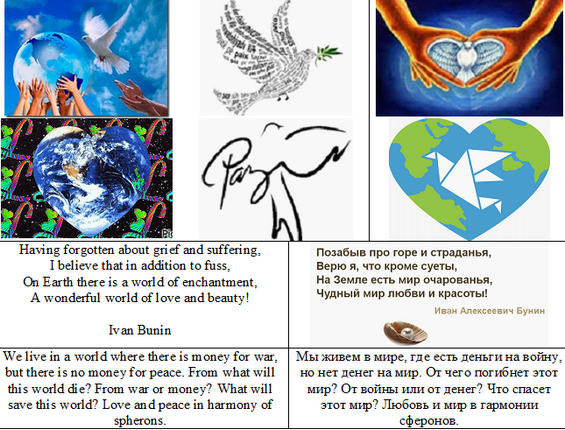
-------------------------------------
Some responses Dr. Leo, mis sinceras felicitaciones por tan nutrido hacer en bien de la humanidad. Cuando se trabaja con amor, el sol tiene otro brillo! Con atentos saludos, Ime Biassoni Argentina Dr. Leo, my sincere congratulations for such a nourished work for the good of humanity. When working with love, the sun has another brightness! With attentive greetings, Ime Biassoni, Argentina ------------------------------------------------------------- Dear Dr. Leo, Congratulations! For a great Journey of Life with great purpose of Life; Peace from Harmony Dr. Subhash Chandra, GHA President and Board Chairman, Global Harmony Association, India ----------------------------------------------------------- Congratulations Dear Leo, you are admirable! Peace and Harmony, love to all, SusanaRoberts, Argentina --------------------------------------------------------- Dearest Leo, Your bio is too brilliant and à heavy. Your actions as a real human and scientist via life give light on our planet à globally. May mercy God save you. With peace via harmony and love Dr Panagiotis (Takis) Dimos Ioannides, GHA Vice President Athens, Greece
---------------------------------
----------------------------------------------------------------------------------------------------------
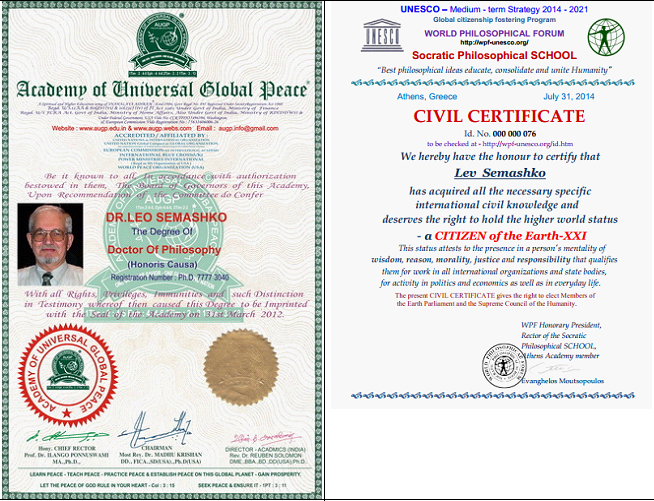
Dear Brother Dr. Madhu! Thank you very much for your excellent Certificates! I am particularly flatter and proud by the Honorary Doctor of Philosophy (Honoris Causa) from your well-known Academy of Universal Global Peace (AUGP): http://www.augp.webs.com. Thank you very much for giving me this honor! I see it as the merit of GHA as a whole. Your high recognition of the GHA achievements will serve to closer cooperation GHA and your Academy on the difficult path of global peace, which can only be achieved in a society of social harmony and harmonious civilization. Our peaceful cooperation from harmony will rise to a new level, when the GHA headquarters will move to India. Your country is a supreme and most ancient culture of harmony in the world, so it is the most favorable for the GHA. Therefore, India became a world leader in the Age of Harmonious Enlightenment, which was opened in New Delhi at the Seminar of teachers February 11, 2012 by presentation of the ABC of harmony. Conscientious and efficient way to harmonious global peace, peace from harmony is possible only through the deep education in the ABC of harmony, which raises the spirituality of individuals and nations to the level of scientific understanding of the universal global peace, to which is dedicated your unique Academy. Our common understanding of this makes us brothers in the spirit of harmony and peace. I think these fraternal feelings are shared by all 27 members of the GHA-India. With brotherly love and best wishes for world peace from harmony, Dr. Leo Semashko, GHA President, 31/03/12 Dear Brother Dr. Leo Here with we are attaching your Ph.D Certifiacte, Induction as Vice President of AUGP (Academy of Universal Global Peace) along with participation certificates. We have passed the Resolution to Induct you as our 1rst ever Vice President of AUGP. You are the first person Sir as Vice President of AUGP & we are proud of you. With Regards & Prayers, Your Brother & Co-Worker, Dr. Madhu, AUGP President, India 31/03/12
--------------------------------------------------------------------------
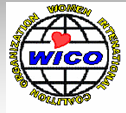
WICO - "Women's International Coalition for Culture of Peace, Non-Violence and Empowered Women" We are honored to hereby present the Emissary of Peace Award to: Dr.Leo Semashko Recognizing your dedication and accomplishment service to the cause of World Peace, particularly through efforts that promote reconciliation among all people, going beyond barriers of Race, Religion, Nationality, Ideology and building Culture of Peace, Non-Violence and Empowered Women.The Emissary of Peace Award is presented on behalf of Dr. Dalia Steiner, WICO'S Founder and International President, "Ambassador for Peace". 2.1.2009 Dr.Dalia Steiner
Dear Dr. Leo Semashko,
Happy New year to you , to all members on board and supporters.
WICO org. "Women's Int. Coalition for Culture of Peace, Non-Violence and Empowerment of Women" NGO (non-profit)supports your initiative: "Requesting the UN to proclaim the decade 2011-2020asa Decade of general harmonious education of children for harmonious global peace”, and the World Congress of Education on Oct. 2009,and will promote it through our chapters around the world. On behalf of WICO's board , we are honored to award you as our organization's "Ambassador for Peace" for your commitment for Harmony and International Peace.
Stay Blessed Best of Luck
Dr. Dalia Steiner WICO Founder and Int. President www.wicohome.org www.wicointernational.org
------------------------------------------------------------------------------------------------------------
Hello, I pay homage to Léo SEMASHKO, this innovative thinker of our inventive time of the tetrasociology (system of the harmony of the spheres). For about ten years, I have been the persevering projection of his work in spite of my difficulty with the English language = difficulty: exit of my situation of quasi blind during the essence of my childhood and my adolescence. His work and those of the network which he animates are a hope for humanity. Previously, and with 2 recoveries, I had the occasion to meet close to Geneva the Professor GALTUNG, one of the pioneers of research for peace, as I had the occasion at the time of several congresses to meet Ernesto KAHAN. The French representation of UNESCO proposed this year for the price to me 2016 MADANJEET SINGH of the tolerance and non-violence, this for 50 years of uninterrupted commitment in favor of peace, the rights and duties human, based on listening and the dialog. Since the end of the Sixties, I went in about fifty countries to protest there by the conferences, poetry, the song = peace and the harmony! At present, I have some pains which make more delicate the long voyages. I remember to have sung the Tyrolienne for Senegalese young children who had never heard this kind of sound and of which the filled up eyes of amazement seemed to leave their orbits. From Russia in the USA, Jordan in the Viêt - Nam, Sri Lanka in Brazil, Mexico in Singapore, China in Turkey, From Japan in Italy, Greece in China, Morocco with Australia, etc. I preached the opening of the heart and the wisdom of the spirit. For Léo = I offer this song “BECAUSE “, whose besides Bruce COOK, who appreciates it, member of the network interpreted it with the French horn for the marriage of his sister. This difficult song is one of that which reveals more the intensity of the harmony between the voice and the instrumental accompaniment. This song was immortalized by Mario Lanza in film which pays homage to the other great voice of the 20th century: that of Enrico Caruso, in film of Richard Thorpe in 1951. This day = I offer it to Léo SEMASHKO! Live peace and the harmony. https://youtu.be/juhYbn5MRj4 Guy CREQUIE Poet, social observant writer, and French singer 19/05/16 --------------------------------------------------------------------------------------------------
Dr. Leo Semashko
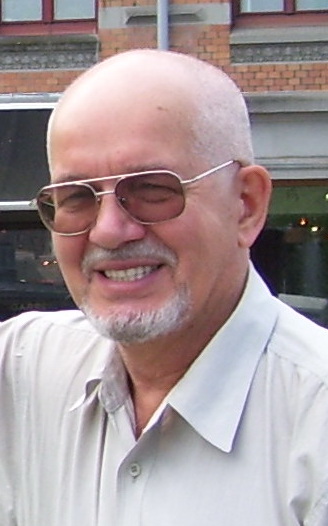
Founder and President: Global Harmony Association (GHA) and
International Website "Peace from Harmony" since 2005
GHA Honorary President and the GHA Board lifelong member
Approved by the GHA on April 12, 2016
In Russian: http://peacefromharmony.org/?cat=ru_c&key=286
Guy Crequie. Two Humanists of Non-Violence: Mahatma Gandhi and Léo Semashko:
Birthday congratulations 2015+2017: http://peacefromharmony.org/?cat=en_c&key=623
2018: http://peacefromharmony.org/?cat=en_c&key=833
In Russian: http://peacefromharmony.org/?cat=ru_c&key=649
Recommendations to Roerich Peace Prize 2015 In English: http://peacefromharmony.org/?cat=en_c&key=639 In Russian: http://peacefromharmony.org/?cat=ru_c&key=661
Leo Semashko. GHA Honorary President: http://peacefromharmony.org/?cat=en_c&key=676 http://peacefromharmony.org/?cat=ru_c&key=667 Leo Semashko. 75-year Jubilee: Triumph of Harmony: http://peacefromharmony.org/?cat=en_c&key=690 http://peacefromharmony.org/?cat=ru_c&key=670
Video, 14 minutes: https://www.youtube.com/watch?v=1tNPQk-StY4
Global Peace Science Hero: http://peacefromharmony.org/?cat=en_c&key=697
World Harmony Creator: http://peacefromharmony.org/?cat=en_c&key=513
Semashko Leo. Children, grandchildren, great-grandchildren: harmony of generationshttp://peacefromharmony.org/?cat=en_c&key=765
Nomination of "The ABC of Harmony" at the Nobel Peace Prize in 2013:
www.peacefromharmony.org/?cat=en_c&key=586
Nomination of the GHA "Global Peace Science" at the Nobel Peace Prize in 2017: http://peacefromharmony.org/?cat=en_c&key=788
Polina Semashko, granddaughter, 12 years old: http://peacefromharmony.org/?cat=ru_c&key=748
My wife Vera:
http://peacefromharmony.org/?cat=ru_c&key=578
Leo Semashko. Human/Humanity Right to Life, Global Peace and Social Harmony.
GHA Declaration 2017. Publication: In English: http://peacefromharmony.org/?cat=en_c&key=798 In Russian: http://peacefromharmony.org/?cat=ru_c&key=744
Leo Semashko and the GHA 20 coauthors from 11 countries. Network Spherons: The UN of Harmony and Global Peace Replacing the UN of Disharmony. Sociocybernetic Model of Spherons’ Global Harmonious Governance (SMSGHG) at the UN level Publication: In English: http://www.peacefromharmony.org/?cat=en_c&key=769 In Russian: http://www.peacefromharmony.org/?cat=ru_c&key=736
Leo Semashko and Subhash Chandra.
One Belt and one Road: “The Great Peace Charter XXI” Initiative:
http://peacefromharmony.org/?cat=en_c&key=844
Leo Semashko and colleagues.
God created spherons. The rest in society is their work http://peacefromharmony.org/?cat=en_c&key=845
---------------------------------------------------------------------------------
Leo Semashko Hymn to Harmony Harmony - the highest universal spirit With life and beauty our world embrace, Creating consent, amity and measurement, Cherishing tact, brotherhood, and grace. Harmony - the energy for creation, The source for love and peace, The novel light for knowing, The meaning for existence and bliss! Harmony - the sun for people and nations, The language we forgot in wars but we all need. The warm of soul’s undying fire We embrace and revive in it!
--------------------------------------------------------------------
Photo session with great-grandson: Rafael, 1 year, Israel,
Saint-Petersburg, 10-06-17
The family saga of enlightenment in "Global Peace Science" (GPS) from harmony. Start
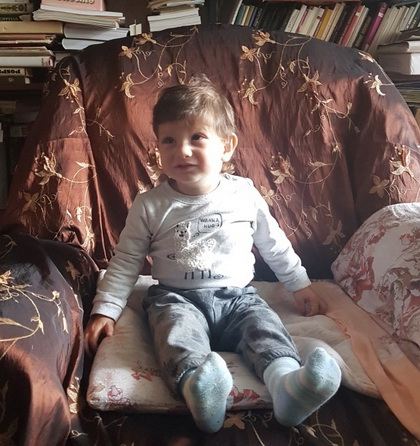
Raphael - future President of harmonious Israel in 2057
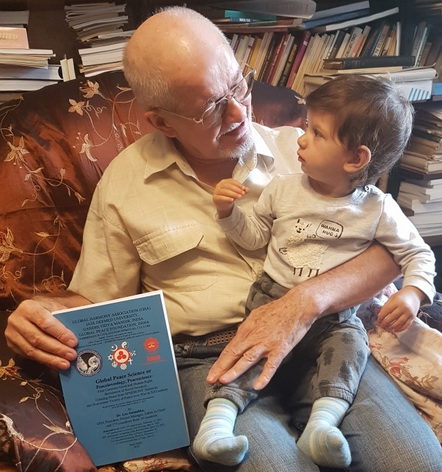
Great grandfather with GPS: what did he brought to read?
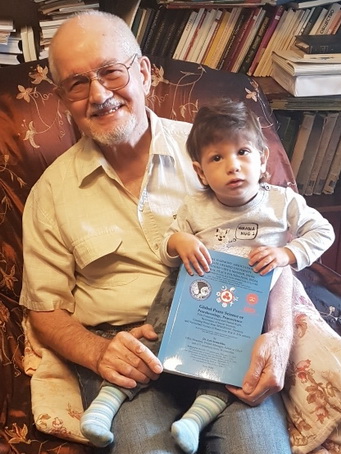
I want to think about this science ....
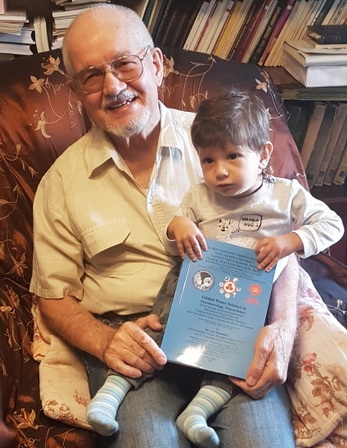
Can I ask you a question?
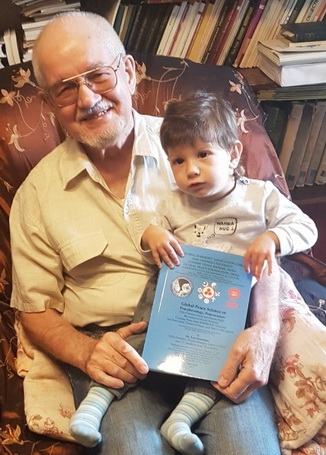
And how is this to be understood?
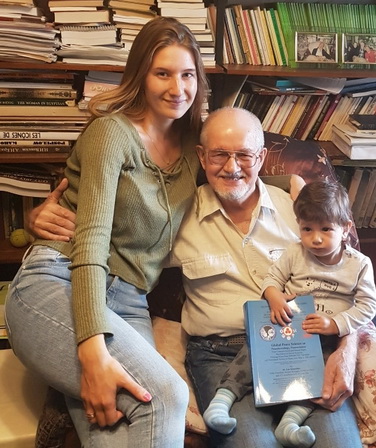
Mom Katya (my granddaughter) joins ...
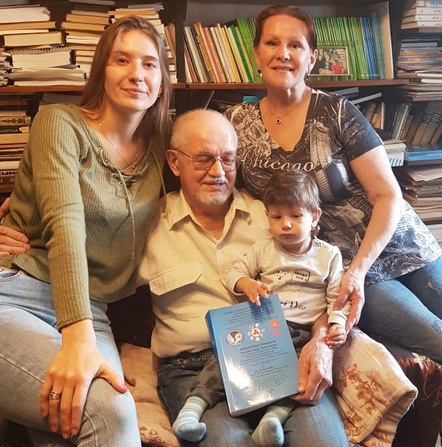
Now the first grandmother Olga joins ...
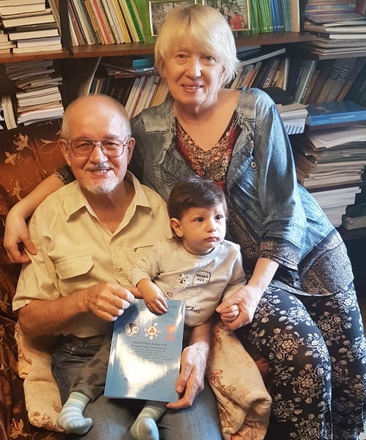
Then the second grandmother Vera joins ...
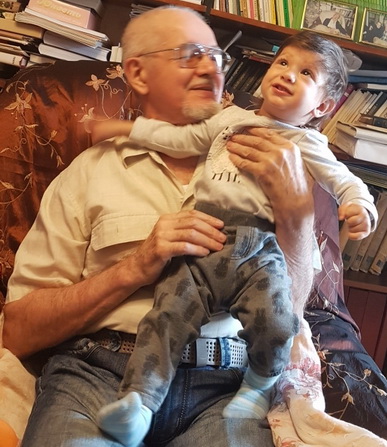
And what is there higher and further with harmony?
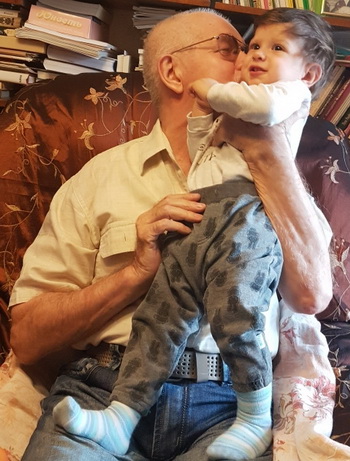
The fusion of generations in love and connection of times in harmony
----------------------------------------------------------------------------------
My photos with great-grandson Raphael (1 year, Israel), granddaughter Katya and wife Vera, May 9, 2017
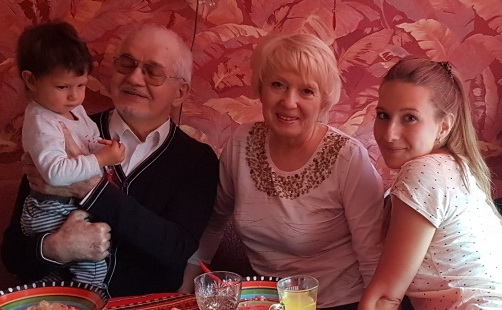
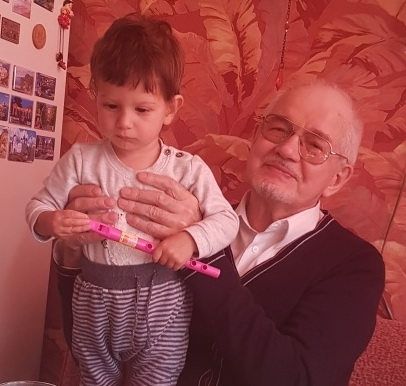
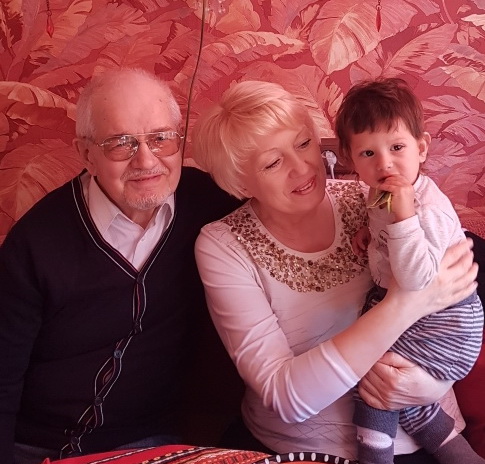
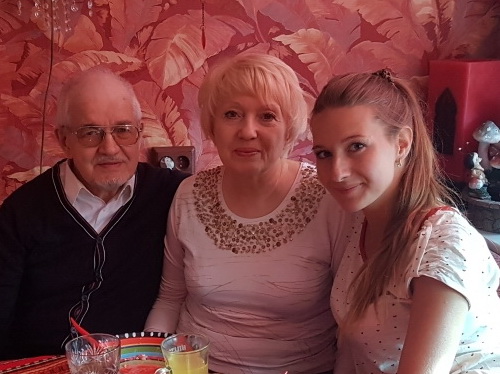
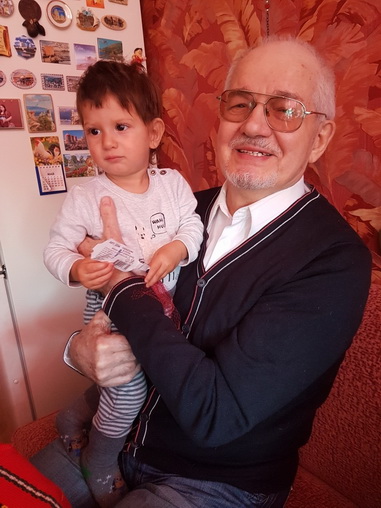
--------------------------------------------------------------------------------------
My photos with Polina and Andrei, June 20, 2012
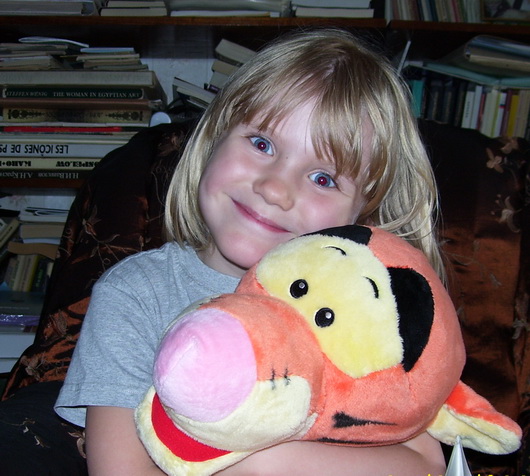
Polina, my granddaughter, President of future harmonious Russia
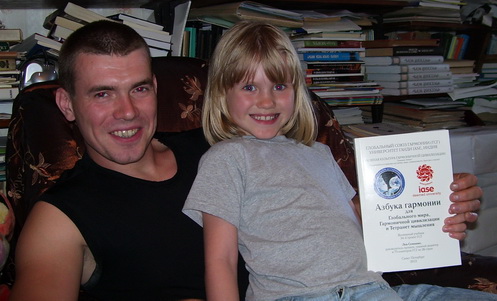
My son Andrei with Polina and the ABC of Harmony for Presidents
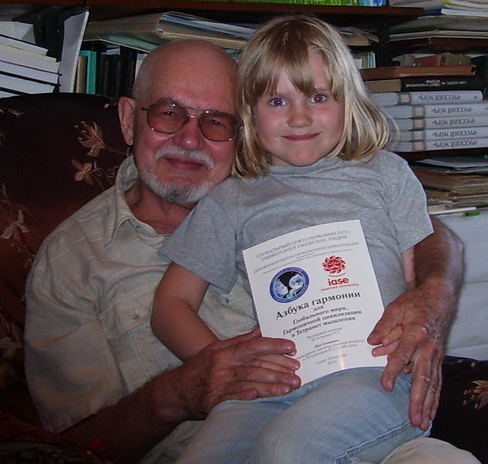
I with Polina and the ABC of Harmony
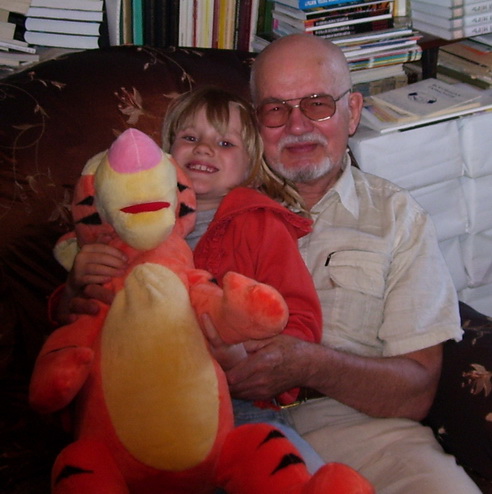
I with Polina and the tiger Leo
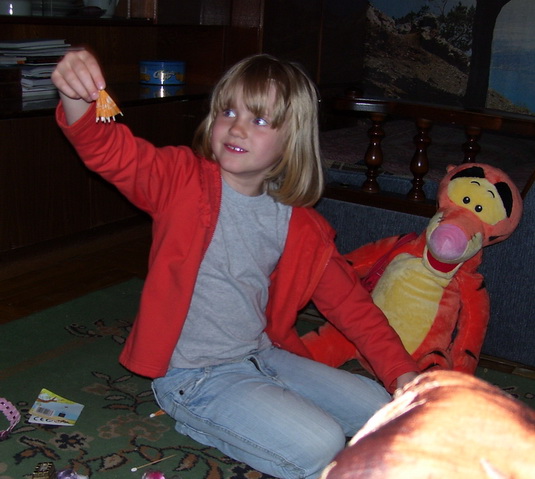
Polina with toys

Polina on thehorizontal bar
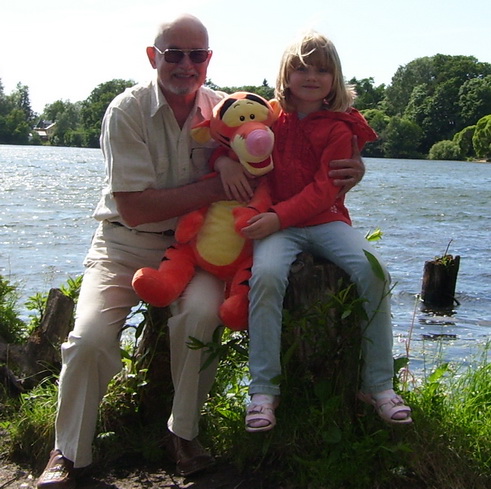
On the lake bank

Andrei and Polina in the boat
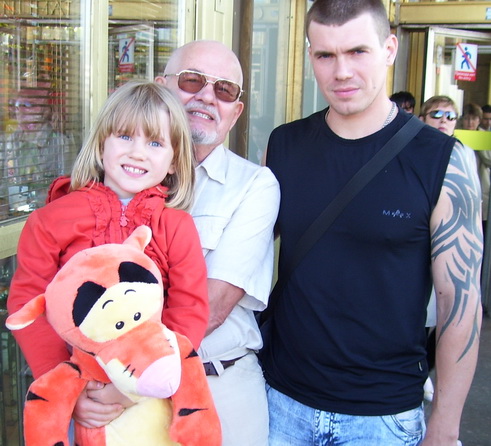
Three of us
-------------------------------------------------------------------------------
Almost all my ideas are submitted on other pages of the site therefore given page is limited by my biography and the short responses about my activity.
Article: LEO SEMASHKO in the first world biographic book - WHO'S WHO 2011:
http://www.acblack.com/whoswho/whoswho.asp?page=biographies.asp
Brief Biography
LEO M. SEMASHKO Birth date and birthplace: June 20, 1941, Grodno, Byelorussia The important biographic detail [from the words of my mother Augusta Rumiantseva (1920-2003)] and its vital consequences. On June 22, 1941 at four in the morning, while Hitler's army began a bombardment of Grodno in Western Byelorussia, my mother together with me was in the maternity hospital. My father, Alexei Lihanov, an army officer, came running to the hospital to tell my mother that the war had started, and that she should prepare for evacuation. She never saw him again as he was killed in the first days of the war.The mothers and babies from the maternity, as well as school children from Grodno were put into freight trainsand sent to the east of the USSR.The train was repeatedly bombed byGerman aircraft, but by miracle was able to continue.My mother and I arrived in the town of Bejestk, Tver region, in the home of her parents. I was in this town that I lived and studied until 1958.Thus I consider Bejestk as my hometown. In 1945 my mother married an army officer, Mikhail Semashko, who adopted me. In 1947, unfortunately, he died unexpectedly. The accounts that my mother told me about the horrors of the war, the bombings and the evacuation, and of the deaths of close persons generated in me a disgust of war, murder and violence. This disgust always pushed me to search for public means to exclude war from the life of all peoples. Such public means will ensure that everyone, including my children andgrandchildren will live in sustainable peace.I have looked for ways to establish lasting peace and have found it in the concepts of social harmony and priority given to children. It is to these goals that my social philosophy "Tetrasociology" is devoted. I have been working on this concept since 1975. Now I am convinced that sustainable (eternal, harmonious) peace can be a consequence only of global social harmony, on the base of “sphere classes” of the population as the main actors of social harmony, “sphere democracy” and the priority given to children, which will replace the current priority of profit as an eternal source of wars. (These concepts of Tetrasociology are explained in details in my books, especially in "Tetrasociology", 2002, which is published on this site on the address: http://peacefromharmony.org/?cat=en_c&key=145). Nationality: Russian Citizenship: Russian Federation Family: Married, two sons: 1961 and 1984 birth, six grandchildren and the great-granddaughter Address: Leo Semashko, 7/4-42 Ho-Shi-Min Street, St. Petersburg, 194356, Russia Tel: 7-812-597-6571 E-mail: leo44442006@yandex.ru Website: www.peacefromharmony.org
EDUCATION 1948 - 1958 - High school 1959 - 1965 - Philosophical faculty, Moscow State University (MSU) 1967 - 1970 - Post-graduate course, Philosophical faculty, MSU. 1970 - Doctoral thesis: "Becoming of the Contradiction Category in a History of an Antique Philosophy (up to Plato inclusively)" (MSU) 1970 - Ph.D. (MSU) PROFESSIONAL EXPERIENCE
Present – 2005: Founder and President, Global Harmony Association
Present – 1998: State Councillor of St.Petersburg,
Present - 1993: Founder and Director, Tetrasociology Public Institute, Russia;
Present - 1970: Philosopher, Sociologist and Peacemarker from Harmony 1994 - 2005: Sociology Professor, St. Petersburg Universities (lecture courses on Sociology, History of Sociology, Sociology of Politics, Sociology of Law, Tetrasociology) 1990 - 1993: Deputy, St-Petersburg Parliament, Commissions Member: Economic Reform; Family and Childhood; 1981 - 1989: Senior Scientific Fellow, Institute "Lensistematekhnika"; 1970 - 1981: Assistant and A/Professor, Philosophy and Sociology Departments, St. Petersburg Universities; (lecture courses on Philosophy; History of Philosophy; History of Sociological Doctrines) 1965 – 1967: Assistant, Philosophy Department, Technical University, Barnaul; 1958 – 1965: Worker, Public Figure, Bratsk Hydroelectric Power Station, Irkutsk Region; SIGNIFICANT COMMUNITY PARTICIPATION 2007 December – present, Advisory Board Chairman, International Association of Educators for World Peace (IAEWP-UN-USA) 2005 November – present, Founder and President, Global Harmony Association; 2005 – present, Founder and President, International Website "A New Culture of Peace from Social Harmony and Children’s Priority", shortly: Peace from Harmony - www.peacefromharmony.org, uniting more than 500 co-authors from 56 countries of the world and publishing in 17 languages; 2005 – present, Human Dignity and Humiliation Studies (HumanDHS), Board member; 2003 – present, St-Petersburg State Councilor; 1998 – present, International Sociological Association, member; 1992-1993: Founder and Head, Sphere Democracy Deputy Group, St-Petersburg Parliament; 1990-1997: Founder and President, F.M. Dostoevsky Children’s Foundation in St. Petersburg; 1990-1991: Founder and Head, Developers Group, First “Russian Family Code” Project, with the first chapter devoted to the children rights; 1988-1990: Founder and Head, Public Group “For Children’s Rights”; 1985-1986: Founder and Head, Preschool Harmonious Development Studio; 1975-1980: Founder and Head, Harmonious Development Youth Club “Demiurge”; 1968-1969: Founder and Head, MSU Students Building Group in Norilsk; 1957-1958: Founder and Head, School Building Group, Bejestk. PARTICIPATION IN THE PROJECTS
Present and for term of life - Projects of global peace from harmony, a list of 47 of which, made, see here:
www.peacefromharmony.org/?cat=en_c&key=472
Present - August 2008: Russia – Georgia: Harmonization through Education instead of Militarization:
http://peacefromharmony.org/?cat=en_c&key=337 Present – September 2007: Global Harmony Association; Present – May 2007: World Harmony/Peace Academy; Present – December 2006: Magna Carta of Harmony; Present – January 2006: Harmonious Era Calendar; Present – May 2005: Global Movement “Making Children a Priority in the World” Present - February2005: International site "Peace from Harmony» Present - 1980 – Sphere Information-Statistical Harmonizing Technology 2003-2005 - Russian law project "Children’s Suffrage Executed by Parents" 2003-2006 - International Publishing Project of Multicultural Dialogue 1993-1998 - Organization and Management at the Different Administrative Levels of Russia and St.-Petersburg. 1990-1993 - "Family Code of Russia" Project; Economic Reform of St.-Petersburg. 1981-1987 - Automated System of the Plan Accounts in St-Petersburg. PUBLICATIONS More 600 scientific works on philosophy, sociology, culture, law and policy, including 18 books and brochures: Leo Semashko’s Books and Brochures 2019. Mahatma Gandhi: Nonviolence Starting Point. Spherons Genetics and Statistics. Gandhica. By the GHA 82 coauthors from 25 countries, Delhi, 240p: https://peacefromharmony.org/?cat=en_c&key=848
2016. Global Peace Science or Peaceloveology, Peacescience: First Common Good and Human Right, Revolution of Social Sciences, Creating Peace from SPHERONS' Harmony and Nonviolent Victory of Peace over War in XXI Century. By the 174 coauthors from 34 countries. World textbook. The first publication in English, Smaran Publication, New Delhi. 2016. 616 p.ISBN 978-81-929087-8-6:
http://peacefromharmony.org/docs/global-peace-science-2016.pdf
2015. Global Peace Science or Peaceloveology: First Common Good and Human Right, Revolution of Social Sciences, Creating Peace from Harmony and Victory of Peace over War in XXI Century. By the GHA 89 coauthors from 30 countries. World Textbook. 432 pages. St. Petersburg, 2015. ISBN – 978-5-7422-4707-4, First Edition in Russian: http://peacefromharmony.org/?cat=ru_c&key=606 - 2012. The ABC of Harmony for World Peace, Harmonious Civilization and Tetranet Thinking.Together with the GHA 75 coauthors from 26 countries. Global Textbook. GHA 34th Project. First published in English in India, New Delhi, Doosra Mat Prakashan, 2012, pages ~334. ISBN – 978-81-923108-6-2: http://peacefromharmony.org/?cat=en_c&key=478
- 2010. Russia, Forward, towards Harmonious Civilization. Together with the GHA co-authors. St. Petersburg, LITA, 30 pages, in Russian: http://peacefromharmony.org/?cat=ru_c&key=435
- 2010. Kazakhstan - Harmonism Strategy for the 21st century. GHA project for the President and the Parliament of Kazakhstan. Together with the GHA 14 co-authors from 10 countries. St. Petersburg, LITA, 22 pages, in Russian and English: http://www.peacefromharmony.org/?cat=en_c&key=445
- 2009. Harmonious Civilization. Global Harmony Association Innovative Projects, with 119 coauthors from 34 countries, in 2 languages. St-Petersburg, Russia, "LITA ", pages 254: http://peacefromharmony.org/?cat=en_c&key=379,
- 2008. World Harmony/Peace Academy and General Harmonious Education in an Information Society, with 64 coauthors from 20 countries, in 2 languages. St-Petersburg, Russia,"LITA ", pages 104. http://peacefromharmony.org/?cat=en_c&key=277
- 2007. Magna Carta of Harmony for an Information Civilization: Toward Social Justice and Global Peace, with 42 coauthors from 16 countries in 7 languages, Lita, 228 p. http://www.peacefromharmony.org/?cat=en_c&key=3
- 2006. Harmonious Era Calendar: Address to Children, Youth and Future Generations, with 26 coauthors from 12 countries in 12 languages, St.-Petersburg State Polytechnic University, 396 p. http://www.peacefromharmony.org/?cat=ru_c&key=190
- 2004. Children’s Suffrage: Democracy for the 21st Century, Priority Investment in Human Capital as a Way toward Social Harmony, St.-Petersburg State Polytechnic University, 72 p. http://www.peacefromharmony.org/?cat=en_c&key=211
- 2003. Tetrasociology: from Sociological Imagination through Dialogue to Universal Values and Harmony, with 14 co-authors, in three languages: Russian, English and Esperanto. St.-Petersburg State Polytechnic University, 394p. http://www.peacefromharmony.org/?cat=en_c&key=149
- 2002. Tetrasociology: Responses to Challenges. St.-Petersburg State Polytechnic University (in Russian and English), 158 p. http://www.peacefromharmony.org/?cat=en_c&key=145
- 2000. Tetrasociology as the Revolution of Social Thinking, the Way of Harmony and Prosperity. St.-Petersburg, 168 p. (in Russian)
- 1999. Sociology for Pragmatists. Textbook for the university students. Part 1, St.-Petersburg, 376 p. (in Russian)
- 1994. The Black Book of Crimes against Children in St. Petersburg. Facts, documents, comments. With 3 coauthors. St.-Petersburg, 68 p. (in Russian)
- 1992. Spheral Approach: Philosophy, Democracy, Market and Human. St.-Petersburg, 368 p. :
http://peacefromharmony.org/docs/leo-semashko-spheral-approach-1993.pdf - 1991. Family Code of Russia. Draft of Children's Foundation of F.M. Dostoevsky. Editor in Chief: Dr.Leo Semashko. St.-Petersburg, 100 p. (in Russian)
- 1981. Integrated Evident Schemes in a Philosophy Course. Co-authors: D.V.Pivovarov, V.F.Setkov, Sverdlovsk, (in Russian)
The reviews of some listed books look at the address: http://www.peacefromharmony.org/?cat=en_c&key=15 and
www.peacefromharmony.org/?cat=en_c&key=506 and etc. SELECTED ARTICLES, REVIEWS AND ABSTRACTS 2006. The Meanings of Cultural Sociology. Review of Jeffrey C. Alexander’s book The Meanings of Social Life: a Cultural Sociology. New York: Oxford University Press, 2003. International Sociology. Review of Books (ISRB), Volume 21, no. 6, November 2006, 834-838 p. 2006. Tetrasociological Approach: Six System Sociocybernetic Innovations for an Information Society. XVIth World Congress of Sociology: Durban, South Africa, July 23-29, 2006 http://www.unizar.es/sociocybernetics/congresos/DURBAN/papers/semashko.pdf 2005. Children First Contra Humiliation. http://www.humiliationstudies.org/news/archives/000813.html 2005.What Ends the Children’s Suffrage Executed by Parents May Serve? Vladimir Kavtorin coauthor. Zvezda, St-Petersburg, p.188-199 2005.Institute of Children’s Suffrage Executed by Parents: Necessity and Consequences. Paper presented at the conference ‘Childhoods 2005. Children and Youth in Emerging and Transforming Societies’, University of Oslo, Norway 2005. Tetrasociology and Social Synergetics // Synergetics and Synergetic Historicism. St.- Petersburg, 2005, p. 243-266. 2005. Children’s Suffrage Executed by Parents: Institute of family Education at Children Antiterrorist (antideviant) Immunity // Childhood and Society: Sociocultural Context. Materials of the Õ11th International Conference "Child in the Modern World ". St.- Petersburg, 2005, p. 55-60. 2005. Children’s Suffrage Executed by Parents: Sociocultural Institute of the Antiterrorist Immunity// Telescope, 2005, 2, p. 30-42 2005. Tetrasociology of Childhood: Theoretical and Political Priority of Childhood through Children’s Suffrage. Abstract for the ISA RC 53 Mid-Term Conference «Marginality and Voice: Childhood in Sociology and Society 2005», Germany, June 23-25, 2005 2005. Tetrasociology: Strategic Sphere Management and Organizational Democracy Abstract for the IIS World Congress, Stockholm, July 2005, Session "Social Change & Organizational Democracy" 2005. Tetrasociology: Global Sphere’s Democracy Abstract for the IIS World Congress, Stockholm, July 2005, Session ‘Global Democratization’ 2004. Children, Youth and Democratic Suffrage in a Globalization Era, http://www.usyd.edu.au/su/social/RC53/Newsletter%2012-04.pdf 2004. Children's Suffrage as a Key Way of Improvement of Children's Well-being in an Age of Globalization. Electronic Journal of Sociology (2004) ISSN: 1198 3655 http://www.sociology.org/content/2004/tier2/semashko.html 2004. Children, Terrorism and Children’s Suffrage. September 9, 2004 (on Russian) http://conflictmanagement.ru/text/?text=373 2004. Tetrasociology as a Response to the Feminist Challenge to Sociological Theory in the Age ofGlobalization. 36th World Congress of International Institute of Sociology, Beijing, China, July 7-11, 2004. Abstracts, p.46. (Session 6 “Globalization and Women”) http://www.iis2003beijing.com.cn/en/AS/S6-6.htm 2004. Children’s Suffrage as a Key Way of Improvement of Children’s Well-being in the Age of Globalization. 36th World Congress of International Institute of Sociology, Beijing, China, July 7-11, 2004. Abstracts, p.72. (Session 11 “Children's Well-Beings in the Age of Globalization”). http://www.iis2003beijing.com.cn/en/AS/S11P1-1.htm 2004. Tetrasociology: Plurotheism Hypothesis as Global Belief in the Age of Globalization. 36th World Congress of International Institute of Sociology, Beijing, China, July 7-11, 2004. Abstracts, p.123. (Session 16 “Religion and Globalization”). http://www.iis2003beijing.com.cn/en/AS/S16P3-6.htm 2004. Alienation of Disharmonious Popular Culture and Way to Cultural Harmony. 36th World Congress of International Institute of Sociology, Beijing, China, July 7-11, 2004. Abstracts, p.376. (Session 68 “Alienated popular culture: the non-reflection of reality in culture”) http://www.iis2003beijing.com.cn/en/AS/S68-4.htm 2004. Tetrasociological Conceptualization of Social Harmony as Key Value of Globalization. Abstract for Session 71 “Social Values in Global Age” of the 36th IIS WorldCongress, Beijing, China, July 7-11, 2004. http://www.iis2003beijing.com.cn/en/AS/S71-8.htm 2003. Processes of a Society Democratizationand Children’s Suffrage // Philosophy of Childhood and Sociocultural Creativity. Materials of the Xth International Conference "Child in the Modern World. Culture and Childhood”. April 16-18 2003. St.-Petersburg, 2003, p. 336-339 (in Russian) 2002. Tetrasociology: Sphere Classes of Population as Harmonious Actors of Sustainable Development. World Forum on Sustainable Development 2002. Website: http://www.irfd.org/events/wf2002/abstracts/theme6.html 2002. Tetrasociology: the Concept of Four-Dimensional Social Space - Time as Four- Dimensional Concept of Society. (RC35) XVth World Congress of Sociology in Australia, Brisbane, July 7-13, 2002. Website ISA: http://203.94.129.73/timetable.html, Search “Participants” "Semashko" 2002. Tetrasociology: Discovery of New Statistics. (RC26) XVth World Congress of Sociology in Australia, Brisbane, July 7-13, 2002. Website ISA: http://203.94.129.73/timetable.html , Search “Participants” "Semashko" 2001. Tetrasociology - sociology of four measurements. Statement of a problem // Sociologicalstudies, No 9, Moscow 2000. Pragmatism // State service. No 4, 2000, Moscow 1998. Sphere/tetra macrosociology: from monism to tetrism // Social reality and the social theories. St-Petersburg INTERVIEWS and ARTICLES ABOUT 1. Want peace therefore prepare to peace. October 12, 2006: http://www.peacefromharmony.org/?cat=ru_c&key=269, (In Russian) 2. Right of vote from the cradle? January 12, 2006: http://www.peacefromharmony.org/?cat=ru_c&key=117, (In Russian) 3. Dr. Leo Semashko: Intolerance is a Reaction of the Uneducated People. Scientist - Sociologist Created Theory of a Survival and Harmony for Humankind. March 14, 2008: http://www.vppress.ru/news/2008/03/14/33/, (In Russian) 4. Interview given to the writer Takis Ioannides for the Greek newspaper “EPIKAIRA” of New Smyrna, Athens, which is published by February 16, 2008: http://epikaira.files.wordpress.com/2008/02/pages_6-11.pdf, (In Greek)
DEAR LEO I SEND YOU SOME ARTICLES IN GREEK NEWSPAPERS, ABOUT OUR MEETING IN ST. PETERSBURGon September 5, 2010 in hotel Europe: http://files.eleftheria.gr/pdf/%7BE1834B96-FC22-4F40-9EC4-58943772B8EB%7D_16-9-10-FYLLO.pdf (NEWSPAPER "ELEFTHERIA", PAGE 6) http://issuu.com/kirikas/docs/16_09_2010 (NEWSPAPER "IMERISIOS KIRIKAS", PAGE 17) http://www.kosmoslarissa.gr/files/pdf/16-9-2010_p8.pdf (NEWSPAPER "KOSMOS", PAGE 8) http://www.eleftheria.gr/viewarticle.asp?aid=22349&pid=9&CategoryID=9 (NEWSPAPER "ELEFTHERIA") http://kamposnews.blogspot.com/2010/09/blog-post_5507.html (WEBSITE "THESSALIAN NEWS") http://www.artfools.gr/?p=17518 (MAGAZINE "ARTFOOLS") BEST HARMONY WISHES Dr. DIMITRIS P. KRANIOTIS September 15, 2010
-----------------------------------------------------------------------
“GHA works for a harmonious international peace” This article is written by journalist Ahlem Charef from http://www.ennaharonline.com/ar/, an Algerian daily Arabic is the second Algerian newspaper, publishing (Algiers, Constantine and Ouargla). It reported on a portrait of GHA, an international association, chaired by Dr Leo Semashko, consists of several thinkers, scientists and artists of different religions, ethnicities and countries. I stressed the great lighthouse has been the association during his participation at Astana in October 2010 and its proposed project, for a dignified and prosperous Kazakhstan. Prof. Ammar Banni, Algeria March 24, 2011 ---------------------------------------------------------------
PARTICIPATION IN THE INTERNATIONAL CONGRESSES
2012: International Seminar on “Teachers Education for Peace and Harmony”, New Delhi, India, February 11-13, 2012:
http://peacefromharmony.org/?cat=en_c&key=511
2010: World Forum of Spiritual Culture on the initiative of Kazakh President Nursultan Nazarbayev, Astana, October 18-20:
http://peacefromharmony.org/?cat=en_c&key=446
2010: First International Congress on Mathematics of Harmony on the initiative of prof. Stakhov, Odessa, October 8-10, Ukraine:
http://peacefromharmony.org/?cat=en_c&key=441
2010: XVII World Congress of Sociology; International Sociological Association, July 11-17, Gothenburg, Sweden:
http://peacefromharmony.org/?cat=en_c&key=434
2008: International Conference "Religion and civil society", Yalta, Ukraine, November 20-22; Presentation: http://peacefromharmony.org/?cat=en_c&key=352 2008: The 18th IAEWP World Peace Congress, Kuala Lumpur, Malaysia, 29th - 31st October; Presentation: http://peacefromharmony.org/?cat=en_c&key=351
2007: The First Cross-Strait High-Level Forum of the Chinese Traditional Culture. China, Beijing, July 5-9
http://peacefromharmony.org/?cat=en_c&key=295
2006: XVI World Congress of Sociology; International Sociological Association, South Africa. Durban 2005: International Conference "Childhoods", Norway. Oslo 2004: 36th World Sociological Congresses of the International Institute of Sociology, China. Beijing 2002: XV World Congress of Sociology; International Sociological Association, Australia. Brisbane SCIENTIFIC INTERESTS FIELD Tetrasociology as the theory of Social harmony and harmonious civilization and peace from harmony. Harmonious/Peace Education. Sociological theory. Children’s Suffrage Executed by Parents. Peace Culture. Classes and Groups. Law. Person. Psychology. Statistics. Information technologies. Practical Application of Sociology. Multicultural Dialogue. Policy. Culture. History of Philosophy and Sociology. POSITION IN ORGANIZATIONS The Board member of three International Organizations: - International Association of Educators for World Peace (IAEWP-UN-USA)
- World Peace & Development Association (WPDA - China)
- Human Dignity and Humiliation Studies (HumanDHS – Norway)
Member, International Sociological Association
Member, International Forum for the Literature and Culture of Peace (IFLAC - Israel)
March 25, 2010 ------------------------------------------------------------------------------------------------
My political credo It is expressed most precisely and shortly in my paper (see below) at meeting in honour of the 20th anniversary of Petrosovet in which the first sprout of harmonious parliamentarism for a harmonious civilization was born. “Sphere Democracy Group” in Petrosovet 1992: The First Political Sprout of a Harmonious Civilization And a Way for Exit of Russia from the Century Failure By Dr. Leo Semashko, Member of St-Petersburg Parliament (Petrosovet) in 1990-1993, Global Harmony Association (GHA) Founder and President, 2005. GHA unites more 350 members from 48 countries. GHA Mission is to pave a conscious way for a harmonious civilization. Paper at the jubilee meeting of MPs in honour of 20 anniversary of Petrosovet Mariinsky Palace, St.-Petersburg, April 5, 2010 Friends! My colleagues have unfolded in their previous papers the value of achievements of Petrosovet as the first embodiment of parliamentarism in Russia for its past and present. Let me, as a philosopher and sociologist-futurologist, to draw your attention to other dimension of its achievements: for the future. What its achievement will not only be remembered but also developed over 50 - 100 years? In infinite pluralism of the democratic Russian revolution in the beginning of 90th years there was one, strange at first sight, political formation. It is “Sphere Democracy Group” (SDG), arising in Petrosovet in 1992 and uniting about ten deputies under my management. Almost 20 years required to us to understand its deep political meaning. I will be limited here only by three strokes. The first stroke is scientific. Tetrasociology (sphere approach) as a science of social harmony of four sphere classes of population was put in the SDG basis. In it Charter, published in my book (“Sphere Approach”, St-Petersburg, 1992, p.355-358: http://www.peacefromharmony.org/?cat=ru_c&key=282), it is written down: “the SDG proceeds … from recognition in any society the four sphere universal classes”. This idea has been developing in our city for 35 years from the youth club "Demiurge" 1976, which was divided in four sphere groups, accordingly to the sphere classes. These classes differ - by employment in one of four spheres of social production, - by number but they are equally necessary, universal and sufficient as without the products of their work there can not be any society. They make a deep, invisible for eyes, structure of social harmony in which they play the defined roles of its actors-creators. They have one purpose – harmony but - different ways to it. They demand a constant conscious coordination through the mechanism of deep harmonious parliamentarism of the sphere classes.It expresses the new, harmonious, four-party democracy built on equal distribution of legislative and executive power between these classes, between the representatives elected by them. But this parliamentarism and democracy cannot show up without a corresponding science. Therefore, before appearance of this science the sphere classes remained unknown and spontaneous, on historical surface in which the priority role is played by their various, private, disharmonious and hostile social groups and classes which are breaking off their deep harmonious unity. The second stroke is historical. The last 20 years confirmed the world tendency toward comprehension and globalisation of harmony, from which each nation wins, by tens of facts. They are presented in the international book of the Global Harmony Association (GHA) “Harmonious Civilization” (St-Petersburg, 2009, 254p.: http://www.peacefromharmony.org/?cat=en_c&key=379) by 120 coauthors from 34 countries. This book is the first example of the new thinking which received the title “Tetranet Harmonious Thinking”. This book found recognition of the many known figures, including the Chairman of the Russian Upper Chamber Mr Sergey Mironov. The GHA fixed 2009 as year of birth of the new, global, harmonious, civilization, connected with two world events: the beginning of “nuclear zero” of the USA and Russia and creation of a science of this civilization which replaces a dying off industrial civilization. Together with these events humanity entered into the Age of Harmony Renaissance and Harmonious Enlightenment. From the point of view of a new civilization, SDG is its first political sprout which has begun its harmonious four-party democracy, i.e. deep sphere parliamentarism. Charles Montesquieu’s fundamental law of democracy, which is ignored by the democratic Constitutions, revives in this sprout: “Durability and prosperity of democracy always depend on the correct division into classes of the population having the right to vote" (Charles Montesquieu. Selected works. About Spirit of Laws. Moscow, 1955, p. 171-172). He gave the examples of Solon’s 4 classes, Servius Tullius’ 6 classes but nowhere he found the "correct" division. SDG found it in the sphere harmonious classes and created the unique projects of the sphere structures of legislative and executive power as state mechanism for the deep consent of these classes. The third stroke is national. In Russia for 20 years there has been a widely known unflattering definition of democracy: it is at all on hearing. It is not very far from truth in view of absence of correct division of the population in classes and ignoring of their deep interests. In general the institute of industrial democracy in the world, except the very rare small countries, degrades and degenerates in the plutocracy expressing political essence of an industrial civilization. Democracy revival at the level of a new civilization is possible only through "correct", sphere, division of the population into classes which found the first political expression in SDG. What to do with this democratic innovative miracle, furnishing the key for revival of all dying modernizations of Russia, the population of which remains in poverty along with its inexhaustible richness of resources? We should not lose this world’s priority, "as always". Because it will go away or to the USA where “harmony schools” are growing quickly now, or to China where almost a quarter of humanity builds “a harmonious society”, or in another country, which will be the first to establish the sphere harmonious four-party democracy together with the related harmonious education of the population. In the 20th century Russia paid the biggest blood in revolutions, civil and world wars for the right to prosperity through social harmony in the 21st century the ideas of which have been developed by the Russian most brilliant minds under the different names: Aleksey Khomyakov’s sobornost, Leo Tolstoy’s nonviolence, Vladimir Solovyov’s all-unity, Nicolas Roerich’s harmony, Paul Florensky’s consent, Vladimir Vernadsky’s noosphereand etc. Already Feodor Dostoevsky intuitively understood the key role of harmony in the words: “A beauty will rescue the world”, as a beauty is identical to harmony. From similar ideas of the outstanding Russian and foreign thinkers was born tetrasociology as a science of social harmony. Why Russia possessing this unique innovative scientific potential would not declare building into the country of a harmonious civilization while something similar has been made by China in 2006?! It will be a very ambitious and very effective Russian modernization of the 21st century, which will allow it to exit from the failure of the last century and to find prosperity at last! Building of a harmonious civilization will not prevent but only will help Russia to struggle with terrorism, corruption and other social pathologies, giving to this struggle a higher social meaning. To start to build it, this is possible in the new presidential project “Sun City” which has a chance to be “Harmony City”, not to die, "as always". The harmonious civilization is the best for Russia the practice and the spirituality, the sources of which lay in depth of Russian culture. At the same time it is the best for Russia national dream, national idea, national strategy and ideology of national consent which will replace the obsolete ideologies of national split: Marxism discrediting locally in the countries of socialism and liberalism, discrediting globally by a powerless before the world financial crisis and global problems. Both ideologies are responsible for the century failure of Russia with 1917 until now.Russia will exit from her century failure and will revive only inthe way of a harmonious civilization and the harmonious parliamentarism which was born almost 20 years ago. This way is opened today by the science of social harmony for all countries. A question arises now: which one of them will be the first will to stand up on it knowingly to get the advantages and priorities of the global harmony? Harmony race goes on to change from human’s arms race of so far! Will Russia take advantage of this new historical chance for her happy future? Thanks for attention. This text is published on the GHA website in English and Russian: http://peacefromharmony.org/?cat=en_c&key=58 http://peacefromharmony.org/?cat=ru_c&key=282 The first responses in Russian mass-media: http://www.ntv.ru/novosti/189852/ http://www.fontanka.ru/2010/04/05/158/ April 6, 2010 ====================================
Global Leader of Social Harmony Charles Mercieca, Ph.D. President International Association of Educators for World Peace Dedicated to United Nations Goals of Peace Education, Environmental Protection, Human Rights and Disarmament Professor Emeritus, Alabama A&M University
We learn from history that leaders are not created by the titles they receive. They naturally emerge from the crowds, thanks to the wisdom and inspiration they demonstrate to others. For over 30 years, Dr. Leo Semashko from Russia has dedicated himself to help create a better world that is characterized by stability, prosperity and peace on basis of social harmony. About this topic he wrote many articles and books and he made six discoveries from his tetra-sociology as to validate his scientific theory.
Characteristics of a Better World The first one consists of the sphere classes of the population as the actors of social harmony, which turn from the spontaneous to the conscious, comprehending a science of social harmony. Just as in the human body all organs work in harmony, likewise in society people can reach social harmony after becoming aware of how the human nature functions. The second one deals with the concept of democracy. It is found in the equal distribution of power among the sphere classes and in children’s suffrage that stems from parental responsibility. This suffrage provides children with top priority in their welfare and in all related endeavors. The third one is connected with the area of statistics, which expresses a quantitative measure of essential resources necessary for social harmony. The fourth one deals with the area of information technology on the sphere statistics base. The fifth one opens the educational and peacemaking socio-cultural technologies ensuring harmonious peace and training for youth for the preservation of cultural and religious diversity. This serves as enrichment among all people. The sixth one covers the area of strategic management/control that guarantees harmonious government and guides to desired social harmony, gearing (coordinating) all levels of politics, economics and finance. These six discoveries for the creation of social harmony open a new vision of the sustainable world and peace beyond war, poverty and violence. Dr. Semashko demonstrates these discoveries not only theoretically but also practically on his International Website: “Peace from Harmony” www.peacefromharmony.org For four years, since February 15, 2005, this website united more than 300 authors from 48 countries and it is published in 17 languages forming around itself a new global community of harmony people. As a result, they formed the Global Harmony Association (GHA). This organization, as the international NGO, has united not only individuals, but also collective members from various groups with more than one million participants from 80 countries. On the theoretical base of Tetrasociology, this Association created 19 collective (from 30 to 120 co-authors) global projects, among which the most important being the following: “Harmonious Era Calendar,” “Magna Carta of Harmony,” “Making Children a Priority in the World,” “Harmonious Peace Culture,” “General Harmonious Education”, “Harmony Academies”, “Harmony Centers WorldNet”, “Alternative Reserve Currency”, “Antinukes Project”, “Harmonious Civilization Universal Declaration” and others are advanced in detail. They include many people and organizations from all over the world. Sound Work and Philosophy GHA sent letters on the creation of Harmony Academies to 12 Governments: China, Kazakhstan, Singapore, Malaysia, India, Argentina, Algeria, Rwanda, Russia, France, England, and Tunisia, in addition to the European Union (EU) and the United Nations as well as UNESCO. Dr. Semashko is responsible for mentioned website. He is also the GHA Founder and President, projects manager and the GHA letters in the Governments initiator. One of Dr. Semashko’s great capabilities has been to bring people together from every walk of life and profession that share the same identical goals of prosperity, harmony and peace. These people tend to be altruistic, that is, ready to undergo any personal sacrifice to help make our planet a better place of habitation where people could live a life that is characterized by good health and education and where they could all feel secure from any kind of physical and social disease. The philosophy of this great Russian scholar is very simple. He views the reality of everything from the Natural Law perspective. The entire world is guided by supreme design that is perfect. Besides, he perceives truth as our mind’s accurate correspondence to the realities that surround us everywhere. Moreover, he visualizes good as anything that is conducive to the universal welfare of all people without exception. This is an edifying spiritual concept of good in contrast to the political concept which views good as the promotion of what is conducive to the welfare of some to the exclusion of others. Lastly, he comprehends beauty as a spiritual element that is more attached to the action of people rather than to their physical appearance. In this regard, persons of the caliber of Mother Teresa, who dedicated her life to help all people without exception, may be properly described as beautiful. In view of this, we may fully realize why Dr. Semashko’s activities depict him as global leader of social harmony. Those, whose philosophy is similar to that of this Russian educator, become also leaders of social harmony. This is due to their ability to turn their dream into a political reality. This has been illustrated by China, which announced in October 2006 its intention of “building a society of social harmony.” Needless to say, there are many other global organizations of modern harmonization. The projected concept of social harmony will undoubtedly extend world-wide. Therefore we may realize why Dr. Semashko, who spent so much energy for its promotion for more than three decades, has earned the title of global leader of social harmony. The world will have everything to gain and nothing to lose by taking his leadership seriously. We should all be grateful for the time he spent and energy he consumed to provide us with a better world.
28/05/09
-------------------------------------------------------------------------------------
December 15, 2008 World requires harmonizing changes! $27 million for World Harmony Academy as GHA strategy. New Year's message. Dear Harmony Academy Authors, Friends! 2008 comes to an end. What are its results? In 2008, through Barack Obama’s election to the United States Presidency, the world understood the necessity of change. Shocks of this year: global financial crisis in USA; youth revolts in Thailand, Greece, France, and Russia, which tomorrow could occur in any country worldwide; continuous multi-milliard swindles in USA and Germany, creeping worldwide, and others. These are the modern attributes of the breakdown of an industrial civilization in addition to its traditional defects: wars, violence, terror, poverty, pollution, armaments and so on. The combination of traditional defects blended with these modern shocks led the world to comprehension of the necessity for immediate changes at last. But what are changing? And in what is direction? What are the mechanisms and processes of change? It became obvious, that the industrial deity — that is, money — is a useless mechanism for making decisions about global problems and it is a very small and narrow yardstick for measuring the accomplishments of human beings. Money, as it is well known, will not buy happiness, love or peace. only harmony, social and individual harmony, can give people happiness, love and peace. only harmony is a complete and adequate measure for humans. Harmonization is the true modern change for humans and the world. Harmonization is the only salvation for humans and the world. Therefore, in 2009, I am convinced that the world will realize this change through harmonization and in harmonization. The conscious, universal and systematic beginning of change toward harmonization, including the means to resolve modern global problems, world crises and youth revolts, can only be General Harmonious Education and World Harmony/Peace Academy (WHPA). The world has closely approached to this consciousness of harmonious education. It has created practically all the necessary resources and preconditions for this purpose. The World Peace Congress of educators in Malaysia, at the end of 2008, approved the WHPA project as a means of educational reform, which is necessary for modernity. Now, it is necessary for the modern world, as stated by Eleanor Roosevelt, to experience an "educational revolution." This educational revolution is required in order to resolve global problems of mankind. The educational revolution is required in order to resolve the youth revolts. Why do young people revolt? It does not suffice for them to have money? Young people revolt because hopelessness in the absence of positive alternatives. Young people revolt because there is an absence of happiness. Happiness can be realized only through harmony. And harmony can be learned only through general harmonious education. If the consciousness of youth is limited by a narrow vocational training and disharmonious knowledge of mathematics, physics, chemistry, biology, economy, engineering, business, and so on, then the consciousness of youth is open to any destructive system or any anarchic revolt. Therefore, the resolution of all crises and revolts of modernity are the SUBCONSCIOUS REQUIREMENT of harmony and general harmonious education. This education is a priority throughout the world! And I am convinced that, in 2009, this WILL BE CLEAR for all. The main contribution to the world’s comprehension and acceptance of harmonization belongs to the Global Harmony Association (GHA), to its ten projects, the crown jewel of which is the WHPA. The brief evolution of our Academic (educational) project since the end of 2007 has concentrated on a search of its financing, in the amount of $27 millionfor the first three years of its first stage. GHA has ALL necessary resources: staff (faculty), information (science), international support and organization for creating the Harmony Academy, EXCEPT FOR $27 million in financing. What is $27 million? It is a very modest payment for the beginning of a system global harmonization through general harmonious education. It is a paltry sum for the budget of any country, even the smallest and poorest. Business venture capitalists, for example, could invest $27 million in the Academy and sell it to a government in three to four years and show a ten-fold profit. Some of the GHA members, panicked by crises, have begun to say that now is not the time to search for money for WHPA. I can not agree with that statement. I think differently. I think the opposite: that the modern crises and revolts REQUIRE that we search for $27 millions. Now is not a time to push a brake, but a time for ACCELERATION toward the realization of this project as a positive global change and as a hope for youth and children. only this Academy is capable of creating every one or two years the essentially new humanitarian technologies of harmonization for youth and technologies for economic and financial harmonization that are capable of preventing these crises from continuing and growing at global and local levels in the future. Therefore, within the conditions of this long crisis, the WHPA project requires expansion of its recognition by others: NGOs, advertising, governments, and funding organizations. We need discussion in MASS-MEDIA, in Congresses of scientists, among teachers and so on. If we, the authors of this project, shall be silent, be inactive, and wait for the mythical "best" industrial times, which never will be, then the positive, harmonizing changes will not be either. Not in USA, nor in Greece, nor in France, nor in any other country. GHA must strengthen our strategies to search for $27 million for Academy financing. This strategy was approved in June 2008. Since then, the chances of the WHPA project coming into existence during these conditions of long crisis are not lowered, but raised. In this respect, we have made much progress. We sent letters to Governments of four countries: Russia, France, Malaysia and Rwanda and to the UN. We prepare letters for 15 Governments: China, Taiwan, USA, Greece, India, Norway, Israel, Japan, Singapore, Lebanon, Kazakhstan, Ukraine (Crimea), Congo (Brazzaville), Kenya, and Cameroon. I am sure that, in 2009, from these 20 Governments, we will be find one, two, or three that will respond positively to our letters on financing. The main problem is the search for the leader or General Director for the WHPA national branch and its team. I think each member of the WHPA General Directorate could be such leader, or be a member of this team, or find team members among friends and prepared youth. I think about each author of the project as the member of a national team for this Academy. Another accomplishment is that our Academic (educational) project has been translated into five languages: Russian, English, Spanish, Chinese and Romanian. It is still necessary that we translate this project into at least four other languages: French, Arabic, Japanese, and Esperanto; the French translation is currently under way, thanks to Prof. Ammar Banni. The WHPA project is being actively advertised by: Alexander Olshansky in Moscow; Genrih Skvortsov in St. Petersburg; Susana Roberts in Argentina; Guy Crequie in France; Charles Mercieca, Robert M. Weir, and Martha Ross DeWitt in USA; Takis Ioannides in Greece; Rosa Dalmiglio in the European Union and China; Jiang Yimin in China; Lana Yang on Taiwan; Maitreyee Roy in India; Jean Basabose in Rwanda; Muhammad Iqbal in Pakistan; and many others. I am sincerely grateful to each of these people for their great contribution to the Academy project. Of significance is that the WHPA project was submitted at two international conferences in 2008: in Kuala Lumpur, where it found support of the International Association of Educators for World Peace, and in Yalta’s Conference on interfaith relations where it caused the large interest. However, these efforts are not enough. Each of the almost 80 co-authors could be telling about this project, its insignificant cost of $27 million, and its highest effect at any public assembly before any audience. This project is urgent for each country in the world. The recognition and destiny of our educational project depends on each of us. I hope, that each of the authors understands this and, in the next year, will define and refine their own initiatives to speak out on behalf of progress of this project. Personally, I am going to be engaged, until February 1, only in the writing of letters to Governments and in finishing our approved strategy. In view of the special circumstances of the previous 2.5 months when I was unsettled, I can not be engaged in any other of our current projects: mathematics of harmony, textbook, article, etc. However, I shall return to active participation in those areas in February, and we shall approve the plan of our work for 2009. I also offer to transfer, during the period of February through May, the updating of GHA Statutes and our membership fees into one of the children's organizations, for example, in Kigali. In this connection, I have asked Jean Basabose to find in this city the poor little children's establishment into which we could transfer our membership fees. There is one more personal problem: my health, which, unfortunately, is not better. The doctors have, for a long time, recommended that I enter a hospital for two or three weeks. Quite probably, I shall be compelled to do that, either prior to or soon after the New Year. As a whole, the 2008 was great for us and for all GHA members. But I am sure, that the next year will be even greater as the practical realization of the WHPA project will begin in one or several countries of the world. Merry Christmas and happy New Year to all you!!! In the New Year, the new steps to harmony, happiness and peace will wait us!!! With love, Dr. Leo Semashko, GHA Founder and President
Leo,
My edited version is on top.
Good New Year's message. I like your conviction and the strength of your language. I pray for your improved health. I forced some paragraph breaks so that readers can receive and appreciate your message in smaller visual pieces.
- Robert Weir,
December 19, 2008
----------------------------------------------------
Dearest Leo, Dear all, Thank you for your warm words on my birthday next 23th. Leo is an Apostle of Peace. My Wishes you get the best successful recognitions and help in this hard work of Peace and Harmony for the new generation. My best wishes from my heart for our Heroes Ada and Dr. Ernesto and all the community of Peace makers around the world. My Love to you and your families. Blessings from my soul.
Merry Christmas and Happy New Year!!!
Susana.
17/12/08 -------------------------------------------------
Interview given to Takis Ioannides,
by the Global Harmony Association President Dr Leo Semashko for the Greek newspaper “EPIKAIRA”of New Smyrna, Athens. The interview is published by February 16, 2008 in this newspaper: http://epikaira.files.wordpress.com/2008/02/pages_6-11.pdf
Interview translation on languages:
Leo Semashko - English  : http://www.peacefromharmony.org/?cat=en_c&key=253 : http://www.peacefromharmony.org/?cat=en_c&key=253
- Russian  : http://peacefromharmony.org/?cat=ru_c&key=286 : http://peacefromharmony.org/?cat=ru_c&key=286
Takis Ioannides - Greek  : http://www.peacefromharmony.org/?cat=en_c&key=322 : http://www.peacefromharmony.org/?cat=en_c&key=322
Ammar Banni - French  : http://www.peacefromharmony.org/?cat=en_c&key=321 : http://www.peacefromharmony.org/?cat=en_c&key=321
- Arabic  : http://www.peacefromharmony.org/?cat=en_c&key=320 : http://www.peacefromharmony.org/?cat=en_c&key=320
Tatomir Ion-Marius - Romanian  : http://www.peacefromharmony.org/?cat=en_c&key=319 : http://www.peacefromharmony.org/?cat=en_c&key=319
Susana Roberts - Spanish  : http://www.peacefromharmony.org/?cat=en_c&key=323 : http://www.peacefromharmony.org/?cat=en_c&key=323
I met Dr Leo Semashko years ago. Us have drew together our common thoughts and targets, like the World’s Harmony and the improvement of life´s living of the children of our world. Ibecamememberandco-writerinhisvision, where I met many others, also inspired, thinking fellow humans, ready to contribute with actions, obvious disinterest with full power, in theseaims and objectives. Our efforts were finally fulfilled, when our books were accepted by nations´s leaders of many countries, by international Social Organizations but mainly, when the country of China adopted our first book, in order to accommodate it in its social system. I have the honor here, to introduce the remarkable interview that was given to me by a REAL HUMAN for our internationally recognized newspaper. Dear Dr Semashko, Which is the definition of culture? More than 300 definitions of culture are present in a social science. I adhere of the most widespread and simple definition: the culture is a preparation (change, processing, creation) of the resources for the human / social purposes. In my tetra-sociological (four-dimensional sociology going from the Greek four-dimensional philosophy of Pythagoras, Empedocles and others) theory differ the four spheres or kind of culture: social or human, spiritual, organizational or political and material or economic one. Certainly, these kinds of culture exist not separately from each other, but only inside each other, in mutual penetration and influence. Name a person whose teachings gave food to you spirit and ambitions. Why? He is the Greek philosopher Plato. I protected in 1970 my doctor's dissertation devoted to the Plato’s dialectics. In my opinion, it is the deepest thinkers in a history of humankind, who ideas remain still not clear till now in many respects. Plato’s philosophy differs by two unsurpassed advantages: 1. Dialectics of harmony of the opposites and 2. Ideal, i.e. harmonious state. The opposites harmony of Plato was replaced and worsened by Hegel and Marx by struggle of the opposites, which consecrated all wars, revolutions and violence of the 19th and 20th centuries. only in my tetra-sociological theory Plato’s harmony of the opposites is restored but at a modern level of an information society. Òetrasociology is constructed on harmony of the four social spheres and four sphere classes of the population. They create an ideal, harmonious society of the four sphere classes of the population, instead of three Plato’s estates. But his idea about the ideal state revives at a modern scientific level in tetrasociology, which is submitted in details on my international site "Peace from harmony": www.peacefromharmony.org. How do you determine the culture of soul and mind? In my opinion, the modern culture of a mind and thinking consists in skill to understand, to express and to use dialectics of harmony (harmonious dialectics) of the four spheres of the world, society and human. The culture of soul is for me the individual culture to feel, to empathize, to promote and to develop dialectics of harmony (harmonious dialectics) of the four individual spheres both own person, and others people. The harmonious mind and soul of the human is harmoniously advanced and harmoniously cultural human as an ideal of the ancient Greeks and Renascence. But it is achievable only in a harmonious information society, that is proved in tetrasociology. What is the characteristic of a real person/human? I count that the characteristic of the advanced human is the internal and external harmony, harmony with a nature and society, harmony in his way of life, feelings, thoughts, speeches and behavior. The characteristic of a real human is disharmony, i.e. narrowness, one-dimensionality, incompleteness and non-wholeness. Which is the mission of an intellectual person/human in our community? Our community arisen on our International site, which was open on February 15, 2005. Both community and site title as "Peace from harmony". Now this community unites more than 240 representatives of the different cultures and religions from 39 countries of the world and is published in 17 languages, including in the Greek language. The main merit in it belongs to the Greek poet and writer Takis Ioannides, as he translated in the Greek language the basic works of our community: Harmonious Era Calendar (2006, by the 38 co-authors from 17 countries), Magna Carta of Harmony (2007, by the 43 authors from 16 countries), the Global Harmony Statutes (2007, by the 32 authors from 13 countries), which arisen on the basis of our community and others. The establishment of the global peace on the basis of world social harmony, including a priority of children and universal harmonious education, is our mission. They say that history is repeated. Is that true? Yes, the history in something repeats, as for example in revival of the Greek philosophy of harmony and Greek ideal of harmony. But at the same time it always is new. As Heraklit spoke, "it is impossible enter one river twice". Would you wish to visit one day Greece; Why? I dream to visit Greece, because it is my spiritual native land and my love. My consciousness and thinking found a beginning in the Greek philosophy and culture. Russian philosophy and culture are continuation and development Greek. I regret, that because of financial limitations I could not visit Greece till now and live in it even two weeks. Or to read a course of lectures on tetrasociology at the Athenian University. It is my dream. Which is the status of harmony and peace today on our planet? Unfortunately, harmony and peace remain in an industrial civilization by marginal. They can become a priority only in an information harmonious civilization, which goes on changing of industrial one. What love means? The love is other party of harmony. The true love is harmony and vice versa. The love is care, help and service to the people, as spoke Mother Teresa. What harmony means? Above I spoke about it in details. Being briefly expressed, harmony is unity, consent and love of diversity. The harmony unites and is expressed in many values: tolerance, respect, understanding, dialogue, compromise, consensus, mutual aid, common good, freedom, equality, brotherhood, happiness etc. Which is the basic element of education? - Harmonious development of the person. An advice to children? - To aspire to harmonious development, to harmony in all, it is happiness. An advice to adults? - To teach children for harmony instead of enmity, that will exclude wars, violence and poverty. An advice to poets? - To create more the poems about harmony of life for children and adults. Immortality or death? - Harmony is immortal, as the world is immortal. Disharmony is mortal. God? - In all religions God is harmony, HE creates the world from chaos. The great German philosopher Gottfried Leibniz entered the "law of divine pre-established harmony". The Golden Rule of all religions, since Confucius is: “Do unto others as you would have them do unto you”. It is the first expression of social harmony. It is submitted in details on our site "Peace from harmony". With what do you deal in your free time? - I do everything to reduce my disharmony. My favorite deals: meetings with my children and grandchildren, conversation and walk with the wife, friends, nature, animals, sports etc. Dr Leo Semashko, Global Harmony Association President http://www.peacefromharmony.org/?cat=en_c&key=249 ---------------------------------------------------
"Peace from Harmony", the Third Anniversary on February 15, 2008: Results, Problems and Challenges Dear Peace from Harmony Authors, Global Harmony Association Members, Friends! I am happy to send you this message with my deep gratitude for your fidelity to the world harmony and with my heart congratulations concerning the THIRD anniversary of our site "A New Culture of Peace from Social Harmony and Children’s Priority" (briefly: "Peace from harmony": www.peacefromharmony.org), which was open on February 15, 2005. Let briefly to tell about our achievements for this year in comparison with two last (http://www.peacefromharmony.org/?cat=en_c&key=253), and also about problems and challenges, with which we confronted. Achievements In past year we continued to carry out our mission "peace from harmony", i.e. creation of the global peace on the world harmony basis. It was expressed in three our major achievements of world importance.
First, it is creation of the Magna Carta of Harmony for an information civilization" by 43 authors from 16 countries, which is the first world document by scientific (tetrasociological) comprehension of social and individual harmony, ways of their achievement and construction on their basis of the global harmonious peace and appropriate culture.
Secondly, it is creation of the Global Harmony Association Statutes, as the first world organizational document for the conscious movement to world harmony.
Thirdly, it is creation of the Global Harmony Association (GHA) as the first world organization of conscious evolutionary movement to world harmony. GHA is, as a matter of fact, a seed and beginning of the new International of Harmony and Peace (or) Peace from Harmony, which essentially differs from the traditional Internationals of an industrial society: they divided the people on hostile camps but not united them for global peace and harmony. GHA creates the scientific and most effective, through harmonious education, way to achieve global harmonious peace for all peacemaking organizations of the world. I am happy to inform, that the first organization on February 10 joining to GHA, is the oldest (with 1969) and one of most powerful NGO: International Association of Educators for World Peace (IAEWP). It is the GHA first collective member. IAEWP has branches in 80 countries of the world and unites more than 50 thousand members. The world famous teacher and scientist Professor Charles Mercieca, the GHA Board member and our “of harmony and peace bell”, is the IAEWP Founder and President. The Agreement about IAEWP joining to GHA is published at the address:http://www.peacefromharmony.org/?cat=en_c&key=316. It can serve a sample for the other organizations, which we call to join GHA. We continued to collect on the site the ideas and persons of harmony from all world and to unite them in the different projects of a harmonious peace culture, which (projects) now are totaled more than 40. The most significant of them is the World Harmony Academy (WHA) project, which practically unites almost all others our projects and gives them a way for realization through harmonious education of children, youth and new generations as world citizens. It is a long but the most effective way for achievement of indestructible harmonious peace and its culture. Spreading WHA and harmonious education worldwide is capable for 15-20 years not only to stop all modern wars but also to prevent all wars in the future. It is the most effective way of the fight for peace. (This project was discussed by 20 Russian co-authors about 3 months. Now it - 25 pages - is translated on the English language and in 2-3 weeks will be submitted for discussion of its foreign co-authors). We begun the new project of a Hymn to Harmony, called to create a poetic and musical masterpiece of modernity inspiring all peoples of the world on creation of global harmony as source of true peace. Since January 19 we received 6 poems: http://www.peacefromharmony.org/?cat=en_c&key=315. Our past projects developed also. So, for example, a number of the Harmonious Era Calendar authors increased up to 42 with 27, and number of its dates up to 53 with 27. The project For Social Harmony in the World in Support of China found wide reflection on the site separate page and appropriate photo-gallery. The Children’s Priority project found a new support in annual transfer of the GHA membership fees in one of children's organizations of developing countries. In this connection let once again to remind you kindly, that the membership fees and donations transfer to disabled children organization, Kolkata, India proceeds up to February 28. (Organization Chief: Dr Maitreyee Bardhan Roy: maitreyee25@rediffmail.com). The site continues to unite cultures of the East and West, North and South. on it all the basic religions and local civilizations of the Earth are submitted. It synthesizes the Western structural idea of spheres and the East value idea of harmony. It overcomes polarization "of two cultures": technical and humanitarian and creates creative unity for science and art. For one year the number of our site authors, who write the wonderful book Peace from Harmony together, increased with 190 up to 254 persons. Each author has brought the unique contribution to our site as a treasury of world harmony by the information of the first-rate quality. Each author deserves the warmest and sincere gratitude all of us. The countries representation on the site has grown with 33 up to 41 countries from all continents of the world. The publications of the site has grown with 15 up to 17 languages. Subjects of our site have extended considerably. only number of the site "Contents" pages has grown with 158 up to 202, though some of them still wait the authors and appropriate information. The friendly sites number has increased with 80 up to 100. In October - November 2007 the GHA Board was created, which includes 8 authors from 7 countries, and also Honorary Advisory Committee, including 23 author from 10 countries. For our site the new place was led. Now it is defined in the GHA Statutes (clause 1) as "the centre of the Global Harmony Association communication space and also its main information body and resource". The site appearance and its Main page changed considerably also, on which the site new emblem in a line of three female symbols of harmony, replacing each other appeared. The merit of the site technical updating belongs to my young colleague, student Ivan Ivanov, to who I am very grateful for it. The site and its forum number of visits for one year increased with 60 thousand up to about 360 thousand. The number of daily visits reached about 1000 and it is not a limit. So, for one year the site authors made the significant contribution to development of a harmonious peace culture. We have all bases highly to estimate this contribution and to congratulate each other with excellent work and productive cooperation. However, for three years the internal problems and external challenges have ripened and aggravated. Problems From many our problems I want to name two. 1. The financial problem has become aggravated up to a limit: I am shame to ask tens time of tens people to carry out laborious works for translation, editing etc. without any of material compensation. The problem of translation on the site is sharpest. More than 2500 texts published on it, wait for translation on its 17 languages. Here I want to express general gratitude and high appreciation to our voluntary translators, who translated and edited for the site tens pages of the different texts: Tholana Chakravarthy, Martha Ross DeWitt, Claude Veziau, Maria Cristina Azcona, Bernard Scott, Reimon Bachika, Susana Roberts, Renato Corsetti, Jan Faullimmel, Takis Ioannidis, Guy Crequie, Nina Goncharova, Robert Weir, Alexander Verbitsky, Tatomir Ion Marius, Muhammad Iqbal and others. All active translators received (or will receive) the Honorary Tittles of our site and GHA.
2. The GHA and site tasks were considerably complicated in connection with their quantitative growth and quality of the new projects. They conduct to an aggravation of the attitudes between us. As all of us are come from an internally hostile industrial society and are still very far from internal harmony, at us (at me including) not always gets the skills and tact of harmony for the harmonious decision of the conflicts. Some our members are not capable to understand and accept a scientific novelty of our projects, therefore they leave organization or remain passive. But on their place the new and young people come, with new energy of harmony, which freshens and updates our Union. All of us learn in harmony, all of us are its pupils but not all and not always we are its excellent student. It is natural process. It should be perceived with understanding, calmness and without a forcing of negative emotions concerning our separate disharmonious trivialities and reactions. The harmony supposes tolerance, forgiveness and magnanimity. Challenges The external challenges go from the aggravating political conditions in the world, from a new coil of arm race, from crisis of traditional peace culture and fight for peace (I have devoted to this crisis special work: A New Quality of the Fight for Peace: http://www.peacefromharmony.org/?cat=en_c&key=301). GHA is non political organization; we do not intervene in the modern political conflicts strengthening enmity instead of harmony. But we can not be outside of them. Traditional peace culture and fight, at all their high moral status, shown the practical powerlessness and full inefficiency. The world movement for peace, all the numerous peacemaking organizations of the last and new century did not know the reasons of peace, therefore they could not stop any war. Efficiency of traditional culture and fight for peace are close to zero. They have only moral importance and are in this respect very important. They are not capable to counteract war in another way. Therefore they are mistrustful to the GHA’s ways and projects and resist to them. And the modern society, which remains in a majority industrial, in general is hostile to harmony and its projects. Our GHA for the first time in the world scientifically, on a basis of tetrasociology, showed a way of an establishment of global peace: harmony of social spheres and sphere classes of humankind and each society. They are a single reason and ground for the global harmonious peace, which we opened in our documents and projects having no analogues in the world. Traditional culture and the fight for peace do not know this reason, therefore they are powerless and are inefficient. The reasons of wars are the private interests of groups and separate countries, which (reasons) are eliminated only by harmony of the universal sphere classes. Therefore movement for peace can be effective not by struggle AGAINST the private militarist interests, but FOR universal sphere harmony. Unfortunately, last is unknown to social science, except for tetrasociology, and to traditional peacemaking organizations, except for GHA. We are in opposition to each other. We throw each other challenge. Our challenge consists that we invite a social science to rise on a level of tetrasociology and the organizations aspiring to the effective fight for peace and peacebuilding to join GHA. Absence of scientific understanding of the reason and source of peace as social harmony and constant arms race are the most powerful challenges for GHA and our worldview. Variant of a temporary defeat of our projects and even of the GHA disintegration therefore is not excluded. But a bit later they will be claimed with necessity, as the objective global harmony tendency, which we see and understand, grows simultaneously. This gives us strong hope for a survival. We fulfil a mission of pioneers for conscious world harmony, harmonious peace and its new culture. This mission is extremely complex; it contradicts to a traditional society and traditional peacebuilding but only it is perspective for humankind. The history of our GHA is a small part of the new, difficult, but inevitable history of a harmonious civilization going on change of an industrial disharmonious civilization. This history includes the European Union with its motto of harmony; Singapore with its Declaration of racial harmony and creation of "the race harmonious nation"; Russia with its “sobornost” as harmony; China with its "building society of social harmony" and culture of harmony going from Confucius; Kazakhstan with its idea of harmony of Europe and Asia; USA with them 14 schools of harmony arisen with 2000 in the states of Texas and Louisiana and other tendencies of an objective harmonization unknown for us. Our merit consists that we consciously and scientifically begun a new history of harmony. Let's congratulate each other with it in day of our third anniversary! Let's wish each other so fruitful movement in the future. With love, gratitude and best harmony wishes, Dr Leo Semashko, The Site and GHA Founder and President 14/02/08 -----------------------------------------
"Peace from Harmony": Second Anniversary. Results and Congratulations
Dear "Peace from Harmony" Authors, Friends!
First of all let me to present you and people of all world in San Valentine’s day (Lovers Day) a delightful art gift of our authors Nina Goncharova (Russia) and Claude Veziau (Canada) as the symbol of deep heart inspiration with creativity of Love, Peace and Harmony on our Planet.
I am happy to send this letter in connection with the second anniversary ofour site "A New Culture of Peace from Social Harmony and Children’s Priority", shortly "Peace from Harmony" ( http://www.peacefromharmony.org/ ), which was opened on February 15, 2005. Its creation began with my acquaintance with Professor Ada Aharoni at the International Sociological Congress in Beijing, China, in July, 2004, where for the first time I learned about her idea of "a culture of harmonious peace". This idea is compatible with my Tetrasociology as a theory of social harmony. Therefore Ada’s idea has inspired me to create our site. It became a daughter Website
of the International Forum for the Literature and Culture of Peace: IFLACPAVE PEACE, the founder and president of which is Ada Aharoni since 1999. She became the godmother for our International and Multicultural site. The key contribution to it, which all of us deeply appreciate and are grateful for, belongs to Ada Aharoni. The site was created by the efforts of an informal international group about 40 persons from 10 countries: Russia – Leo Semashko, Dmitry Ivashintsov, Grigory Toulchinsky, Alexander Yuriev, Vladimir Kavtorin, Andrei Stolyarov, Valerie Isaev, Michael Lebedinsky, Maria Abolskaya, Anne Butkevich, Nicolas Gudskov, Vaycheslav Ivanov and others; Australia - Hilarie Roseman; Israel - Ada Aharoni; Japan - Reimon Bachika; Argentina - Maria Cristina Azcona; Brasil - Araken Guedes Barbosa, Francisco Gomes de Matos, Lia Diskin; Britain – Bernard Scott; Germany – Bernd Hornung; India - Ananta Guri; USA - Martha Ross DeWitt, Rose Lord, Rudolf Siebert, Bernard Phillips, Lynn Comerford and others. During the preparatory period, October 2004 to February 15, 2005, we discussed about 10 variants of the site’s Mission, a set of variants of its title and contents, and prepared about 30 publications and translations. The site since the first day had three languages: Russian, English and Esperanto, in one month was added Portuguese, then Spanish etc. As the site’s Mission we recognized the creation of a new culture of harmonious peace and its social base through appropriate international movements and projects. The site was called to collect the ideas and people of harmony from the entire world and to unite them in the different projects of harmonious peace culture. What has been created on the site by its authors during these two years? The site unites cultures of East and West, North and South. on it there are contributions from almost all religions and civilizations. It synthesizes the western structural idea of spheres and the eastern values of harmony. It overcomes the polarization "of two cultures": technical and humanitarian and creates a creative unity of science and art. on the site, approximately half of the publications concern science and half - the arts, literature and poetry. on the site, there are texts not only of "adults" but also "children" culture such as children's drawings, photos, magazines etc. It overcomes a break of generations, giving a lot of pages for youth. And all this is subordinated to the idea of the formation of harmonious peace culture preventing war, poverty and violence. General strategic and integrated aspiration to social harmony, which alone is capable to ensure global peace and to prevent wars, poverty and violence, are embodied in the various international actions on the site. We have made a start for two global civil movements: "Making children a priority in the world" and "For social harmony in the world ". The last movement is created for the support and promote worldwide building a society of social harmony in China, which began it since 2007. We have developed the two first projects of a harmonious peace culture. The first is the "Harmonious Era Calendar", which includes now 38 peaceful dates and unites 35 authors, from 15 countries and is published in 15 languages. The book with a "Harmonious Era Calendar " is distributed to many countries and is in more than 100 libraries of cities and universities on all continents. The second project is the Magna Carta of Harmony, which has brought together ideas from 50 authors on the site. We have developed the first educational project "Culture of Harmonious Peace". We have offered to create at the UN and worldwide the Universities / Academies of Harmonious Peace Culture, or with a shorter title: Universities / Academies of Social Harmony. We have offered to lead in 2010 the World Conference "Culture of Harmonious Peace", and proposed that the UN establish the decade 2011-2020 as "Decade of Harmonious Peace Culture for Children of the World ". We have supported Ada Aharoni’s idea about the creation of a “ World TV Satellite for Harmonious Peace Culture”. These and other initiatives of our site bring an essential contribution to strengthening peace on the Earth and a new culture of harmonious peace. During these two years, the number of the site authors, who writetogether the wonderful book “Peace from Harmony”,has increased from 40 to 190 persons among which are 17 children. Each author has brought a unique contribution by information of top quality to our site as a treasury ofworld harmony. Therefore each author deserves the warmest and sincere gratitude all of us. The representation of the countries on the site has grown from 10 to 33 countries from all continents. The publication has grown from 3 to 15 languages: English, Esperanto, Russian, Spanish, French, Greek, German, Portuguese, Japanese, Chinese, Arabian, Hebrew, Ukrainian, Romanian and Urdu.
But on 7 of them only the Harmonious Era Calendar is published. The problem of translation on the site is great, as all translations are made voluntary as we have no means for payment for regular translation work on the site. The translation for 10-15 languages is needed for more than thousand texts published on our site. Here I want to express our general gratitude and high appreciation to our voluntary translators, which on good will have translated and edited the tens of text pages for our site: Martha Ross DeWitt, Claude Veziau, Maria Cristina Azcona, Araken Guedes Barbosa, Reimon Bachika, Renato Corsetti, Takis Ionides, Rose Lord, Guy Crequie, Nina Goncharova, Robert Weir, Alexander Verbitsky, Tatomir Ion Marius, Muhammad Iqbal and others. All active translators and also almost all co-authors of "Harmonious Era Calendar" have received (or will receive) a top HONOURARY TITLE of our site: "Creator ofWorld Culture of Harmonious Peace".
During these two years the subjects of our site have extended considerably. The site "Contents" has grown from 47 to 158. A numbers of friendly site links has increased from 8 to 80.
In October 2006, the site Board was created which includes 10 authors from 8 countries: Ada Aharoni, Israel; Reimon Bachika, Japan, Claude Veziau, Canada; Nina Goncharova, Russia; Renato Corsetti, Italy; Charles Mercieca, USA; Leo Rebello, India; Leo Semashko, Russia – Board Chairman; Bernard Scott, England; Abram Jusfin, Russia. For each Board Member a personal page with the biography, photo and presentation texts is open. The Board approved the strategic plan of the site for 2007 and following years. Its main direction are the development of the Global Movements for a priority of children and social harmony; the creation of an International TV Satellite for harmonious peace culture; the development of the International project "Harmonious Era Calendar ", in particular, its publication as a small brochure in one language in different countries for mass circulation in schools, universities, and among students, parents and teachers; the nomination of our projects, first of all "Harmonious Era Calendar " for various International Prizes. It is already been accepted on one of them with the sum of 200 thousand dollars. The award
will be known in one year. The site appearance, its Main Page has changed considerably. on it has appeared a site epigraph in Martha Ross DeWitt’s wonderful words: "Social harmony begins with each of us". on the site menu on the Main Page new rubrics have appeared, for example, "Tell a friend", "Charter of Harmony", "Slides - films" etc. The site Forum was updated also. The large merit for this support belongs to my young colleague, student Ivan Ivanov, who for two years has helped me to solve technical questions on the site. I am very grateful to him. It is useful to note that the number of site visits and its forum for the two years is about 60 thousand. So, for two years the authors of our site have brought a significant contribution to the statement of peace, and development of a harmonious peace culture. We highly appreciate these contributions and congratulate each of us for the excellent peacemaking work and productive cooperation. Its result is the formation of the nucleus of a new global community of harmony people. It may be that the birth of this community, which is unique, within an information society is the main achievement of our site. These achievements allow me, on behalf of the site authors, to offer in the Harmonious Era Calendar one more date: "Global Harmony Community Day" or "Pioneers Day of GlobalHarmony Community" on February 15 in honor of the opening our site. (Please, send me your offers for this date). This date, in my opinion, will be the best monument for our site and his authors. With love and deep gratitude,
Dr Leo Semashko,
Site Founder and President
February 14, 2007
--------------------------------- Robert M. Weir Dr. Leo Semashko: a Global Leader of Peacemaking through Harmony and Children True peace can be inevitable, says Dr. Leo Semashko, but only through social harmony and harmonious education of all children of the world. Dr. Semashko, who lives in St. Petersburg, Russia, and holds a doctorate of philosophy from Moscow State University, has been working to confirm that idea for 30 years. In 2002, he published his vision, Tetrasociology: Responses to Challenges, which demonstrates that the population’s four social spheres must partner in order to transition the human family from enmity and war to cooperation and care. While Tetrasociology, Dr. Semashko’s major discovery, would ensure social harmony and prevent war, he also declares the need to make harmonious education of children a social priority. “Children’s education in families, schools and universities must evolve to an understanding of global harmonious sphere classes and, thus, initiate a new civilization beyond war,” says Dr. Semashko. Leo’s endeavor was destined from childhood. BorninGrodno, Byelorussia, on 20 June 1941, Leo experienced war at the age of two days. He and his mother, Augusta, were still in the maternity ward when, amidst German rocket fire, Leo’s father, Alexei Lihanov, a Russian army officer, told his wife to evacuate. That was the couple’s final conversation, as Alexei was killed only a few days later. Riding on a freight train, Augusta and her infant miraculously arrived in Bejestk, where they lived with her parents and where Leo experienced his youth and teen years. Still today, Leo expresses disgust at the horrors of war. Inspired by his two sons and four grandchildren, Leo sought not only to establish theoretical concepts but to develop practical measures that would bring about social harmony. Between 1975 and 1993, he founded and headed six organizations devoted to children and family rights. Through this work, he came to understand that “social harmony and appropriate peacemaking can only be achieved on a scale that includes all humankind, not merely a framework of one country or a small group of countries.” From that revelation, Dr. Semashko created a web site, “A New Culture of Peace from Social Harmony and Children’s Priority,” (www.peacefromharmony.org) that, since 15 February 2005, has united 190 authors from 33 countries whose essays of peace and wisdom have been translated into 15 languages. These authors, whom Leo hails as “a nucleus of a new global community of harmonious people,” have created two projects: “Harmonious Era Calendar” and “Great Charter of Harmony.”
Dr. Semashko’s ability to bring together great thinkers and creators from diverse cultural, social and political backgrounds marks him as a global leader of social harmony.
Robert M. Weir 709 Regency Square, Apt 302 Kalamazoo, MI 49008 269-978-6803 Robtweir@aol.com www.RobertMWeir.com February 27, 2007 ----------------------------------------------- Professor Terrence E. Paupp 10597 Porto Court San Diego, CA 92124 (858) 571-0896 tpaupp@aol.com TO: Center for Advanced Study RE: Letter of Reference for Dr. Leo Semashko BY: Professor Terrence E. Paupp DATE: June 15, 2007 TO WHOM IT MAY CONCERN: My name is Terrence E. Paupp.I am a retired college professor.Currently, I divide my time between work as the Vice-president of the Association of World Citizens (AWC) in San Francisco and as a Senior Research Fellow at the Council on Hemispheric Affairs (COHA) in Washington, D.C.The bulk of my time is spent authoring academic articles and books.My two major books are: (1) Achieving Inclusionary Governance: Advancing Peace and Development in First and Third World Nations (Transnational Publishers, Inc., 2000) and, (2) Exodus from Empire: The Fall of America’s Empire and the Rise of the Global Community (Pluto Press, 2007).The subject matter of both of my books corresponds in many respects to the work of Dr. Leo Semashko.I was introduced to Dr. Semashko by my friend and colleague, Dr. Charles Mercieca.Dr. Mercieca is the president of an NGO called the International Association of Educators for World Peace (IAEWP).At his request, I served from 2001-2005 as the National Chancellor of the United States for the IAEWP.Insofar as the IAEWP is represented by National Chancellors in over 100 countries it is not surprising that I would eventually be introduced to people of stature in academia who share similar interests, concerns, and goals.It is in this context that I was introduced to Leo in December 2006. From the very beginning of my voluminous email correspondence with Leo, I have been introduced to his work on Tetrasociology, his international multicultural and multilingual website, and one of his published works entitled, The Harmonious Era Calendar: The Quality of Social Existence and Future of Children---with contributions by 27 authors from 12 countries in twelve languages (English, Esperanto, Russian, Spanish, French, Greek, German, Portuguese, Japanese, Chinese, Arabian, and Hebrew).This work reflects the fact that writers in all languages are trying to be a remarkable paradigm for the global community.The process of peace is being initiated in these conversations, in this interactivity where nothing is as important as the building of respect.It is to Leo’s credit that he has been able to orchestrate such a wide variety of academic talent, from many different disciplines, from all around the globe.Certainly, his academic background in philosophy has equipped him well to work with others in shaping a new paradigm for the global community.Peace from harmony is that paradigm. - The Importance and Promise of the Proposed Research:
Leo’s proposal has global implications, but for the sake of empirical clarity he has chosen to apply the Tetrasociological approach to two countries---the United States and Russia, in order to compare the dynamics of their equality and inequality for the period of the second half of the 20th century.Using a four-dimensional sociology, he is seeking to compare the dynamics of their equality and inequality both within and between these two nation-states.Yet, it is his focus on what he calls “sphere classes” which is most important and promises, in my opinion, to yield the most fruitful results.He takes the 4-spheres of social reproduction and argues that among spheres and sphere classes people are reproductively employed in each sphere.In going beyond the Western emphasis on mere quantification, Leo seeks to synthesize the Western structural concept of spheres of reproduction with the Eastern concept of harmony----using harmony as a value.This marriage between Western and Eastern processes of thought serves to underscore the importance of evolving a normative framework for human evolution that transcends quantification as an end in itself.He astutely recognizes that quantification is a necessary but not sufficient element or tool for the kind of research that he is undertaking.In this task, he seeks to examine the interplay between the social sphere, the cultural or informational sphere, the organizational sphere, and the economic sphere.Such an inter-disciplinary approach has not been attempted since the work of the Frankfurt School of Critical Theory (Fromm, Marcuse, Adorno).In this regard, he seeks to reveal the dynamics of how sphere classes of reproductive employment are more fundamental than class distinctions based on property.This is a very important hypothesis to be tested.For by removing the study of reproductive employment from a strictly capitalist framework it is possible to undertake, as Karl Marx sought to do, an analysis of societies with regard to degrees of equality and/or inequality changing over time.Insofar as property ownership is temporary it cannot act as an accurate measure---over time---of what really is at work in forging equality and/or inequality both within and between nations.Leo suggests that what is required is a new focus upon reproductive (sphere) employment as a constant and universal reality that is inherent in all human activity.In this regard, similar to my own work, he will be able to look at the evolution of the global community from a perspective that is no longer tied to just the capitalist ethos and capitalist culture.In this regard, I believe that his work has the capacity and capability to transcend the rather murky debates about globalization and the neo-liberal economic model that has been so much in vogue in the last 20 years.Further, his proposal promises to look at similar sphere tables for the United States and Russia that will create an empirical base for scientific research on inequality and equality for the last half century.Such a comparison promises to yield some amazing findings and insights for many academic disciplines. - The Intellectual Distinction of the Applicant’s Previous Work:
It is clear from Leo’s resume that both his doctoral dissertation and his post-graduate work prepared him well for what amounts to a 30 years undertaking that is still in progress.Further, his professional experience exhibits a marriage between scientific rigor and an equal attention to norms, universal values, and laws.By his ability to invoke his concerns with a new culture of peace in juxtaposition to the current condition of nation-states and the disorder faced by the international community, we see that Leo is seeking to apply his “sphere approach” to the most vexing problems associated with democracy, markets, and social thinking.His numerous publications on Tetrasociology and the emphasis that he places upon dialogue and universal values, points toward a new way of conceptualizing human interaction and human relationships throughout the global community.In this regard, his approach is also historically grounded.For just as an age of agriculture was replaced by industrial civilization, so now we find that the age of industry and technology is reaching its limits and its potential as a framework for human evolution and the human good.Further, the fact that nations have created empires in conjunction with industrial and technological power has in no way eliminated wars and the continuous search for hegemonic dominance.In short, the globe’s political culture remains addicted to war and empire as a way of life.Yet, this addiction is going to be forced to a brutal end as the environmental realities of global warming and climate change threaten the existence of the entire global community.Hence, global solutions and global thinking beyond ideology and nationality are even more important as we contemplate the possibilities for human survival.Survival will entail making better judgments---but not within the context of an old paradigm that has outlived its time and usefulness.As with new wine in old wineskins, the old framework of thought and action must yield to new realities and to a new paradigm of thought and action.In this critical regard, Leo’s emphasis upon creating a “Magna Carta of Harmony for an Information Civilization” has necessarily extended the borders of his research into a larger contemplation of how to move toward social justice and global peace. In my own work on achieving “inclusionary governance” and overcoming the negative realties of “exclusionary governance” I have sought to reach a similar end.While my expertise has been in the areas of international law, history and economics, it seems that Leo’s work in science, philosophy and Tetrasociology has uniquely equipped him for a task which he has outlined with qualities of originality, timeliness, and great potential impact.In fact, the extent to which there has been such a great global responses from other authors and academics from around the globe to Leo’s work on harmony as the goal of a new global civilization that is already in a state of becoming is testimony to the relevance of Leo’s project and proposed course of research.Just as the work of scientist has raised consciousness about global warming and climate change, so too I believe that Leo’s work can raise consciousness about the ways in which global peace can be achieved within a global community.Certainly, his work to date is vivid testimony of such a conclusion. - The Accessibility of the Applicant’s Work to a Multidisciplinary Audience:
Perhaps on of the greatest strength’s of Leo’s work and proposed course of research---which is already visible---is the degree to which it has garnered international attention, devotion and interest.It seems to me that Leo’s work embodies the proverbial notion of “an idea whose time has come.”Scholars in different fields have already joined with Leo in fleshing out his ideas and refining them from the perspective of their own expertise.Over the period of the last 6-months I have been privy to reading almost constant emails from scholars from around the world who have contributed their ideas and input to a final draft of Leo’s “Magna Carta of Harmony for an Information Civilization.”I am proud to say that I am among that group of scholars who have been formally acknowledged for my specific contribution to his work.Leo has taken from my work in Exodus from Empire the idea that industrial democracy and the imperial project of empire is turning into “democratic despotism” and “inverted totalitarianism.”In its place, Leo has termed the alternative “Sphere Democracy.”I have described it in other terms, but our vision is a shared vision and very simpatico.In terms of the broad sweep of Leo’s past work and current research---as embodied in his proposal to you---we find that the great German philosopher, Gottfried Leibnitz, established the idea of the “world divine law” (“harmonia praestabilita”) three centuries ago.However, according to Leo, “until now, the value of harmony was not recognized as a universal, global priority.It has now become possible only within the framework of a global, information civilization, developing within and replacing the conflict orientations of industrial civilizations.”Leo posits that China has made the first step by proclaiming harmony as a national ideal.Many scholars, including myself, concur with Leo’s diagnosis that the old industrial civilizations are largely “unconscious” of the benefits to be derived from an alternative approach to empire, hegemony, and other forms of dominance and exploitation.Hence, I can attest to the fact that Leo’s work already may be seen as accessible to a multidisciplinary audience because many of us see and acknowledge the importance of what he calls the “spontaneous harmony of sphere classes” because “conscious harmony will begin with self-identification of sphere classes (as social actors) in an Information Age (post-industrial society).”In my book Exodus from Empire, I refer to this phenomenon as a “counter-hegemonic alliance” against global empire.Left movements in Latin America are seeking to join together in regional accommodation and cooperation to resist the intrusions of the American Empire.China is successfully reaching out to the nations of Southeast and East Asia, as well as Africa, in creating a “counter-hegemonic alliance” to empire and the abuses of industrial civilization.In Leo’s proposal, at both the theoretical and the empirical levels, we can observe the fact that he is seeking to reveal the nature of this dynamic by giving due attention to both a quantitative description of sphere classes (at the theoretical level) and finding the common statistical parameters (at the empirical level).It is for this reason that Leo can argue in his proposal that the content of the research makes it necessarily interdisciplinary.That is why he will have an audience for his work. - Collegial Interaction and Research Collaboration:
I believe that it should be evident from all of my remarks (above) that Leo has the potential to benefit from and contribute to the collegial interaction that is so vital to the CASBS community. In closing, I would only state that I believe that CASBS will be greatly benefited by accepting Leo for this work and research.I have the greatest respect for him and for the worldwide acclaim that he already enjoys.I am, with every good wish, Sincerely, Terrence E. Paupp ------------------------------------------------- TO: Selection Committee Center for Advanced Study in the Behavioral Sciences Stanford University
REFEENCE LETTER Dr. Leo Semashko Kyoto, 25/6/2007 I’m writing this reference letter on behalf of Dr. Leo Semashko whom I came to know since the XVth World Congress of Sociology in Brisbane in 2002. I met Dr. Semashko again at two other congresses in 2004 and 2006. on two occasions he presented a paper in sessions I organized as President of Research Committee Futures Research (RC 07) of the International Sociological Association. From our first meeting on he impressed me with his friendly appearance and his original and unusual sociological approach to the problems of our world. Wanting to understand his thought, I studied his Tetrasociology: Responses to Challenges (2002) and found it quite impressive. At heart, Dr. Semashko seems to be a visionary, but his views are based on a remarkable sociological theory that wants to be objective using statistics. It shows consistency and a high degree of sophistication.It is a multidimensional, critical theory of individual and social life. Semashko proposes a new model of society centering on four basic resources: people, information, organization, and things/technology. As such, the theory looks quite simple but it is rather complicated when it comes to societal coordination. It is a theory with political implications. Its main political suggestion concerns a reformulation of the idea of stratified social classes thus far based on property and social power into non-hierarchically ranked classes that are based on the reproductive employment of people. With an emphasis on values, Semashko’s theory does not critize Western democracy or its political institutions. It only strives toward greater democratization, showing great moral concern for the well-being of all people everywhere. As such, it displays indeed remarkable sociological thinking by a scholar who was born and raised in a Communist regime. Good social theories without endeavor to implement them into social or political policy are more or less sterile. As a sociologist near retirement I know that theory and policy are two different things and that existing policies are immensely difficult to change. As a viewer of daily television and a reader of, among others, Athony Giddens, Sigmunt Bauman, and Ulrich Beck, I know that modern societies face enormous problems that will not change unless societies and culture change. Semashko has not only been adventurous but also audacious enough to propose ideas for change. He merits a greater chance in his endeavor, which he himself has begun with his website Peace from Harmony, for which he is working hard. Cf.www.peacefromharmony.orgI support and cooperate with him as much as possible. It allows me frequent email contact with him and his work.
To conclude, Dr. Semashko is a well organized, exceptional, and ambitious scholar. There is no doubt in my mind that he does not meet the criteria of CASBS: importance of his project (the importance of his ultimate goal is self-evident); capacity to pursue his research; originality (particularly in his conception of society); multidisciplinary communication (this is clear from his website), and collegiality within CASBS. For the last point I can testify that he is a very sociable person with whom it is a pleasure to associate. His capability of communicating in English is not perfect but this should not be a problem – I am myself not a native speaker of English. For all this, I would like to recommend him enthusiastically and with confidence for a CASBS fellowship at Stanford. I would be happy to answer any questions and to provide further information. Yours sincerely and respectfully, Reimon Bachika Professor,Dept of Sociology Past President, RC 07 Futures Research, International Sociological Association Tel. +81-75-491.2141; Fax. +81-75-493.9032; Email: bachika@bukkyo-u.ac.jp Address: Bukkyo University, Dept of Sociology 96, Kitahananobo-cho, Murasakino Kita-ku, KYOTO 603-8301JAPAN ------------------------------------------------------------
International Sociology Review of Books Vol. 22 No. 2; March 2007 The Scope of Sociology DeWitt Leo Semashko, Tetrasociology: Responses to Challenges. St Petersburg: State Polytechnic University, 2002, 158 pp., ISBN 5742202634, US$15.00.
Leo Semashko and 14 dialog contributors, Tetrasociology: From Sociological Imagination through Dialog to Universal Values and Harmony, in Russian, English (trans. M. R. DeWitt) and Esperanto. St Petersburg: State Polytechnic University, 2003, 396 pp., ISBN 574220445X, US$25.00
Leo Semashko, Children’s Suffrage: Democracy for the 21st Century, Priority Investment in Human Capital as a Way toward Social Harmony, trans. M. R. DeWitt. St Petersburg: State Polytechnic University, 2004, 72 pp., ISBN 5742206550, US$5.00.
keywords: Information Age ✦pluralism ✦social reproduction ✦sphere classes ✦ sphere democracy
Tetrasociology is an ambitious attempt by Professor Semashko to synthesize a long tradition of theories of societal reproduction, introducing or integrating concepts such as: the reproductive employment of people, social harmony/disharmony and four dimensions of social space–time. A central premise of tetrasociology is that sustainable development and maintenance of society (homeostasis) is provided by a natural law of social harmony (balance) achieved among four spheres of social reproduction. This harmony is constantly challenged by deviations (conflicts) within the four spheres, among various branches (social classes), enterprises, regions and social groups. The strength and number of deviations (conflicts) create a measure of disharmony. When this exceeds a critical measure, the society either perishes or the law of sphere harmony is subordinated for a time, until sphere harmony can be restored. Harmony among spheres and sphere classes (of people reproductively employed in each sphere) exists in two forms: spontaneous and conscious. Spontaneous harmony of sphere classes is the natural, historical basis for preserving societal stability, whereas conscious harmony will begin, Semashko anticipates, with self-identification of sphere classes (as social actors) in an Information Age (post-industrial society). Thus, tetrasociology posits social harmony not o¬nly as the basis for society but also as its ultimate goal.
Tetrasociology synthesizes the western structural concept of spheres of reproduction and the eastern value concept of harmony. The concept of harmony of reproductive spheres of society is the central focus and core premise of tetrasociology.
Semashko develops six ‘discoveries’ (predictions) from this synthesis: (1) self-identification of sphere classes of the population will transform them into conscious actors, striving for harmonious cooperation among spheres; (2) sphere democracy will be based on an equal distribution of power among sphere classes, among generations and between genders, transforming democracy into an instrument of social harmony; (3) sphere demographic statistics will provide a quantitative measure of representation prerequisites to enhance sphere-generated social harmony; (4) sphere information-statistical technology will be developed to calculate potentials for increasing social harmony; (5) sphere sociocultural technology will be able to measure achievement and maintenance of social harmony; and (6) sphere strategic management techniques will be developed to ensure harmonious governance of spheres and sphere classes, at all levels of political, economic and financial regulation.
Semashko distinguishes between (a) the subject and product/capital of sphere reproduction, and (b) the reproductive employment of people within each sphere.
a. The four spheres of societal reproduction identified by Semashko are the social, informational, organizational and technical. The resource/capital reproduced within each sphere is for society as a whole, for the benefit of all of its spheres. Consequently, the spheres must work together to achieve social harmony. The social sphere reproduces the resource/capital people, the informational reproduces the resource/capital information, the organizational sphere reproduces the resource/capital of organizations (political, legal, financial) and the technical sphere reproduces the resource/capital of things (material). Each sphere includes many branches (at times conflicting) and enterprises (at times competing). And each has a large number of resource inputs and product outputs, through which they exchange the capitals that reproduce society as a self-organizing cybernetic system. The reproductive employment of people in these spheres is essential to the process of reproduction in all spheres, and unites them in o¬ne self-reproductive system. The fundamental concept of reproductive employment of people covers life from birth to death, and includes all forms of social action, interaction, activity, labor and behavior. Semashko identifies four dimensions of social space–time: resource/capital (social statics), processes of reproduction (social dynamics), structures-spheres of reproduction (social structuratics) and social time: the various states of society from growth through decline (social genetics).
b. The primary reproductive employment of the population is divided into four productive sphere classes: (1) socioclass: (in the sociosphere) includes workers in education, healthcare, welfare, sports and entertainment, and also non-working population: pre-schoolers, students, the unemployed, the retired; (2) infoclass:(infosphere) includes workers in science, culture, communication and information services; (3) orgclass: (orgsphere) includes workers in management, politics, law, finance, defense, police and security; and (4) technoclass: (technosphere) includes workers in industry and agriculture. Classes of reproductive employment are more fundamental than class distinctions based o¬n property. Property ownership is temporary, partial and inherently unequal, whereas reproductive employment is constant, universal and, although qualitatively different, inherent in all human activity.
In Tetrasociology: Responses to Challenges, Semashko lists 75 practical applications of tetrasociological theory (pp. 138–40) to meet challenges of the 21st century: terrorism, religious and ethnic strife, nuclear proliferation, poverty, ecological degradation, demographic dislocation and crises of democracy. Among the applications are sociocultural projects in problem areas, such as: family, gender, education, religious tolerance, international bilingualism, innovative statistics and information technology, anti-terror strategies and ecological preservation. In brief, Semashko believes that civilizations are founded on a naturally occurring social order of four, easily identifiable population groups, unequal in size but equally essential to societal functioning. He contends that, if each of the four sectors is sufficiently represented in the development and use of resources, a society will enhance its ability to flourish, but if one or more of the sectors is not sufficiently represented, a civilization will decline.
To the end of doing comparative studies in collaboration with international research institutes, Semashko has invited dialog with other sociologists, both in Russia and internationally. His book Tetrasociology: From Sociological Imagination through Dialog to Universal Values and Harmony(2003), is written with 14 contributors, from four continents, in three languages: Russian, English and Esperanto. It includes 10 dialogs considering various aspects of tetrasociological theory by sociologists from the US, Japan, Australia, Germany, the UK and Russia. A further publishing project in Esperanto is planned as a way to continue unbiased dialog between civilizations, and to create a global culture of peace.
Another project proposed by Semashko in this book is the establishment of a ‘Faculty of Social Harmony’ to provide ‘humanitarian education for dialog and peace’. Semashko contends that the militarization in education (which exceeds the degree of its humanitarianism) emphasizes preparing the young for war and violence rather than for constructive dialog. He would select faculty members from four educational disciplines, corresponding to the four spheres of society. An educational program teaching ways in which the spheres interact to achieve harmony, to be introduced at all grade levels, would have far-reaching consequences, he believes, for individuals in everyday social relations, and for society at every level of social organization.
Ten dialogs with tetrasociology, by social scientists from six countries, introduce ideas that respond to and expand the insights of tetrasociology from various individual and shared perspectives. In the first two dialogs, Phillips (US) and Bachika (Japan) see Semashko moving toward a New Age of Enlightenment. In the next two dialogs, Yuriev (Russia) and DeWitt (US) continue this critique from the perspective of political psychology and power sharing. Yuriev, who posits a 12-dimensional psychological typology of understanding, sees a need for greater development of Semashko’s concept of harmony, and of mechanisms of ‘formation of the new classes in the new era’ (p. 199). DeWitt integrates central ideas of Phillips, Semashko and her own to suggest (p. 201) ‘a combined approach to resolving global disputes equitably and peacefully’. Research is proposed (p. 204) ‘to compare alternative ways of sharing power’.
In dialogs five and six, Roseman (Australia) and Isaev (Russia) look further into the implications of tetrasociology for communication and negotiation skills required for conflict resolution. Roseman (p. 206) presents McLuhan’s ‘four part metaphor of the transformation process’, applies it to tetrasociology (p. 209), and asks (p. 210) ‘Is transformation of the world possible?’ and ‘under what restrictions?’ Isaev suggests (p. 215) greater development in tetrasociology of the notions of information and energy. Butkevich, Kondratiev and Cvetkova (Russia) review the history of Esperanto since its creation as an international language in 1887 (p. 217) as ‘a means of uniting people . . . in a neutral language’ for multicultural dialog that would ‘preserve the diversity of languages and cultures of the world’.
Hornung (Germany) and Scott (Britain) view sociocybernetics and tetrasociology as interdisciplinary and multidimensional sociological theories. Presenting four tables of concepts (p. 225–9) with 28 sociological concepts listed, they show corresponding concepts in sociocybernetics and tetrasociology. In the last two dialogs, Kavtorin and Lebedinsky (Russia) present practical and philosophical critiques of Semashko’s work. Kavtorin offers a practical reason for taking seriously all attempts at ‘grand theory’ (p. 234) ‘as a stimulant for elaboration of a new “general theory” of sociology’. Lebedinsky, continuing a 10-year dialog with Semashko, offers seven well-articulated criticisms (p. 236–7) of the philosophical foundations of tetrasociology, then closes with (p. 238) five ‘major strengths of tetrasociology and of a tetraoutlook’. A potential dialog is presented in an essay by Govorov, who suggests (p. 244) the development ‘of bona fide scientists capable of taking control of all social development processes’.
In Semashko’s third book in English, Children’s Suffrage: Democracy for the 21st Century, Priority Investment in Human Capital as a Way toward Social Harmony (2004), he develops what he believes to be a practical consequence of tetrasociology. This third treatise, together with the first reviewed earlier, is directed toward educating for a culture of peace in an Information Age, as global consensus toward achieving social harmony to prevent wars and to counter terrorism. Semashko’s third book is devoted to what he sees as an urgent need for children’ssuffrage executed by their parents. He responds to a resolution of the UN Special Session on Children (May 2002). Children’s suffrage is presented by Semashko as an effective political institution for a global movement, to modernize democratic representation, promote a culture of valuing children as future citizens, and eradicate the origins of terrorism in childhood. Replacing the state’s priorities on military and economic spending with priorities o¬n children and their reproduction of the social sphere will effectively promote a culture of peace.
Semashko supplements the concept of children’s suffrage with practical suggestions for its institution. First, he proposes an international comparative research study to determine the likelihood of parents’ acceptance of children’s suffrage. Second, he proposes a project to determine an appropriate law for Russia. Semashko has created a website – www.peacefromharmony.org – to promote the idea of working together to achieve global peace by ‘putting children first’.
Tetrasociology and its derivative proposals are presented in anticipation of, and in preparation for, a global culture of peace, rooted in what Semashko believes to be a natural, evolving order of social harmony. His ideas about child suffrage express his urgent concern for reproduction of the social sphere, which is uncertain if the development of children as future citizens is given low priority. He believes in practical applications of sociology, an optimistic view in the face of increasingly difficult challenges in the 21st century. His style bears the imprint of pre-Communist Russia, suggesting an intense, searching-for-answers mentality. His approach may seem naive, in challenging deeply embedded, long-accepted, confrontational, conflict-oriented ideas about the natural order of things, but he is thorough in developing his logic, and hopeful that others will judge his practical insights on their merit. Semashko’s positive contribution is to focus our attention on sectors/spheres of society that work together to reproduce each other, as well as themselves, and thereby provide an underlying structure of social harmony (latent, at the global level). In its optimistic search for practical outcomes, tetrasociology is a sociology for post-industrial societies, and qualitatively different from the sociologies of industrial societies.
As with any social engineering proposal, Semashko’s formula for achieving global harmony and world peace will invite multidisciplinary anticipation of potential consequences. How might the power brokers of 21st-century societies, in their strategies for barter, trade and information exchange, adapt to, manipulate or try to control this new form of democratic representation, formalized as sphere power sharing? Could there be regimentation and loss of freedom? Or a renaissance of creativity? Who will decide, in an Information Age?
Dr Martha DeWitt is project director of an upcoming study of teen habits, goals and motivation under the auspices of a US medical college. DeWitt’s book, Beyond Equilibrium Theory (Lanham, MD: University Press of America; 2000), presents theories of social action formation and transformation applied to a study of family power sharing in transition.
Address: 2145 N 60th St., Milwaukee, WI 53208, USA. [email: mrossdewitt@sbcglobal.net] It is put on April 21, 2007 ---------------------------------------------------------- Dr Bernard Phillips, USA, Review of Leo Semashko’s book: Tetrasociology: Responses to Challenges (2002, 158 p.). The Canadian Review of Sociology and Anthropology on line: http://alcor.concordia.ca/~csaa1/BookReviews.htm LEO M. SEMASHKO, Tetrasociology: Responses to Challenges. St. Petersburg: St. Petersburg State Technical University. 2002, 158 p. (Introduction by John Rex; Foreword by Dr. Bernd Hornung and Bernard Scott) TetraSociology: Responses to Challenges opens up for contemporary sociologists a window that looks out onto Enlightenment ideals that not only persist but are being carried much further by at least one contemporary Russian sociologist. It is indeed hard to imagine how those ideals could in fact be extended as far as its author takes them, given his experiences of attempting to keep his sociological ideas and ideals alive in a dictatorship for decades, and given the economic problems faced by academics in contemporary Russia. Yet there are parallels to this outside of Russia, for we might also wonder how Western sociologists like C. Wright Mills and Alvin Gouldner managed to stay with those same Enlightenment ideals despite the horrors of the twentieth century and the resulting pessimism and cynicism inside and outside of the academic world. Imagine, along with Professor Semashko, a world that is moving toward a new Age of Enlightenment where globalization, multiculturalism and the internet are working to yield ever more harmony among all the peoples of the world. This is not a postmodern world with a pessimistic view of the potential of the scientific method. Rather, it is a "postpluralistic" world which follows postmodernism in its openness to complexity and change. But it is optimistic about the possibilities of the scientific method for understanding complexity and change by integrating elements of many theories, versus maintaining the isolation of diverse theories which fail to communicate with each other. Just as people in that world are learning to interact so as to pay full attention to others’ ideas and ultimate worth and even to create a "dialogue among civilizations" so are social scientists learning to integrate the work of those who have preceded them so as to follow scientific ideals for a social science that cumulates rapidly. Professor Semashko does not assume that such a world emerges all by itself, for he follows Auguste Comte in seeing sociologists as working to bring it about by addressing modern problems in a highly effective manner. He coins the term "TetraSociology" to refer to the kind of sociology which can accomplish this, a discipline that has a breadth similar to what Mills called for in The Sociological Imagination (1959) along with the reflexivity that Gouldner called for in The Coming Crisis of Western Sociology (1970). That breadth is based on Semashko’s own background as a philosopher no less than a sociologist, including a metaphysical and epistemological stance along with his theoretical and applied orientations. And just as modern sociologists have emphasized the nature and extraordinary impact of language on shaping the individual and society, so does Semashko attempt to use that impact by coining many new concepts, such as "tetrasociology."
To illustrate Semashko’s approach, his metaphysics is oriented to three dimensions of social space and one dimension of social time, corresponding to the three dimensions of physical space and one dimension of physical time. Just as Einstein related space and time, so does Semashko see the linkage between social space and social time as crucial. In this way, he alerts us to the importance of probing into our own metaphysical assumptions. What is our own worldview or Weltanschauung, a concept that may appear to be outdated to modern sociological eyes? What impact does that worldview have o¬n every stage of the research process? Why don’t we social scientists devote the attention to this topic that it deserves instead of continuing to rule out metaphysics and philosophy from the realm of sociology?
As for the relationship between social space and social time, Semashko is telling us of the centrality of the latter if we hope to understand the former, and he is indirectly criticizing the relatively static nature of the social sciences. This is arguably a frontier of our discipline. At the macro level this is illustrated by the efforts by comparative-historical sociologists to face up to the complexity of history, carrying further the more simplistic orientations of figures such as Toynbee, Spencer, and Sorokin. At the micro level it is illustrated by the work of symbolic interactionsts, ethnomethodologists and rational-choice theorists who attempt to probe deeply into the scene, capturing changes in emotions and speech from one moment to the next with audio-visual technology. Metaphorically, I am reminded here of Edwin Abbott’s Flatland (1952), a science-fiction story written in the 1880s, where a three-dimensional sphere is able to see into all of Flatland’s two-dimensional houses and inhabitants by hovering over them. Analogously, we require a four-dimensional perspective that includes social time to see into the our own nature, probing into the history of the individual and society in order to understand present-day behavior. Here we have Semashko carrying further the long-term historical orientation illustrated by Marx, extending it to the momentary scene.
If we turn to Semashko’s epistemology, we find--implicitly--a profound critique of our modern approach to the scientific method. His postpluralism calls for the ability of the social scientist to make good use of all of the relevant theoretical ideas from the past in investigating any given problem. Yet sociologists are divided into numerous specialized areas and literally hundreds of subspecialties, and they generally fail to communicate across specialized and subspecialized lines. This is illustrated by the division of the American Sociological Association into no fewer than 42 distinct Sections with their own organizations and immunity to outside ideas. By contrast, Semashko’s ideas bridge many specialties, as called for in Bernard Phillips’ Beyond Sociology’s Tower of Babel: Reconstructing the Scientific Method (2001) and the edited volume Toward a Sociological Imagination: Bridging Specialized Fields (2002).
There are many questions which Semashko raises. Viewing TetraSociology from a theoretical and applied perspective, why does social stratification persist throughout society, by contrast with the cultural value of equality? What are the forces which are presently yielding sexism, ageism, classism, and ethnocentrism? Why is Durkheim’s "normal division of labor" -- with the worker’s awareness of his or her contribution to society as a whole -- in fact an "abnormal division of labor"? Given what we have experienced in the 20th and early 21st centuries, is a "new Age of Enlightenment" a realistic possibility? How would Semashko analyze any particular social or theoretical problem in some detail and come up with insights which go beyond what we have learned from the contemporary sociological literature?
Professor Semashko comes out of modern Russia with ideas that are in some ways more revolutionary than those of Karl Marx. Just as Toynbee saw human history in terms of challenge and response, he attempts to respond to accelerating modern problems by pointing toward the possibility of a new Age of Enlightenment. He suggests nothing less than changes in the metaphysical stance of modern society, based on the potential weight of language. And he goes back to what may well prove to be the future of social science: the ideals of the scientific method and the enormous breadth of the classical sociologists. Yet, like Moses, he may have brought us to the Promised Land yet be unable to enter it himself. For he fails to demonstrate how his broad metaphysical, epistemological, theoretical and applied approach to social science yields deeper insights into any major social or theoretical problem. Perhaps if we contemporary sociologists can learn from Semashko to rekindle the fire of ideals that gave rise to the Enlightenment and the origins of sociology, a fire that we desperately require in these times of troubles, then we may learn to enter that Promised Land. [Book Reviewer’s notation: given the dearth of knowledge about Russian sociology, I accepted this review as a means of stimulating international awareness. Readers may want to correspond with Professor Semashko at ] Dr Bernard Phillips ------------------------------------- Reviews 1. Bernard Scott and Bernd R. Hornung, Reviews of Leo Semashko’s book: Tetrasociology: Responses to Challenges (2002, 158 p.), Journal of Sociocybernetics, V4, N2, Fall/Winter 2003-2004, p.40-46, www.unizar.es/sociocybernetics/ 2. Bernard Phillips, Review of Leo Semashko’s book: Tetrasociology: Responses to Challenges (2002, 158 p.). The Canadian Review of Sociology and Anthropology on line: http://alcor.concordia.ca/~csaa1/BookReviews.htm 3. Reviews of Leo Semashko’s book: Tetrasociology: from Sociological Imagination through Dialogue to Universal Values and Harmony. With 14 co-authors. In three languages: Russian, English and Esperanto. St.-Petersburg State Polytechnic University, 2003; on Esperanto Websites: http://ttt.esperanto.org/Ondo/Ondo/108-lode.htm#108-40 "La ondo de Esperanto", http://gxangalo.com/modules/news/article.php?storyid=727http://www.ikso.net/novosti/blog/31.07.2003/1; etc.
Up
|